'Tiger King' figure 'Doc' Antle pleads guilty to trafficking wildlife and money laundering
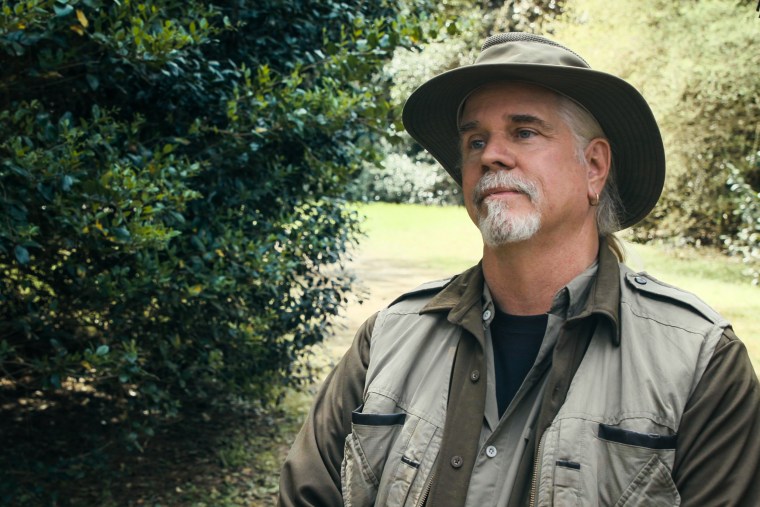
Bhagavan “Doc” Antle, the owner of an exotic animal safari in South Carolina who gained recognition from the hit Netflix documentary series “Tiger King,” pleaded guilty Monday to trafficking wildlife and money laundering, federal prosecutors said.
Antle, 63, of Myrtle Beach, South Carolina, oversaw the sales or purchases of two cheetah cubs, two lion cubs, two tigers and a juvenile chimpanzee, all of which were protected under the Endangered Species Act, from September 2018 to May 2020, the U.S. attorney’s office for South Carolina said in a statement .
That violated the Lacey Act, a law that prohibits trafficking of illegally taken wildlife, prosecutors said.
Antle also pleaded guilty, prosecutors said, to conspiracy to launder money.
"Antle used bulk cash payments to hide the transactions and falsified paperwork to show non-commercial transfers entirely within one state," prosecutors said. "Antle also requested that payments for endangered species be made to his nonprofit so they could appear as 'donations.'"
Antle was known for the 2020 Netflix docuseries “Tiger King: Murder, Mayhem and Madness,” in which he and his South Carolina safari and its big cats were featured.
He is the owner and operator of the Myrtle Beach Safari, which is also known as The Institute for Greatly Endangered and Rare Species, or T.I.G.E.R.S., prosecutors said. The safari is a 50-acre nature preserve that offers tours and the chance for private encounters with wildlife, prosecutors said.
Antle is also the director of a nonprofit group registered in South Carolina called the Rare Species Fund, prosecutors said.
In addition to trafficking wildlife, an investigation also turned up evidence of money laundering committed from February to April 2022.
That occurred, prosecutors said, when Antle and a co-conspirator "conducted financial transactions with cash they believed was obtained from transporting and harboring illegal aliens."
“To conceal and disguise the nature of the illegal cash, Antle and his coconspirator would take the cash they received and deposit it into bank accounts they controlled. They would then write a check to the individual that had provided the cash after taking a 15% fee per transaction,” prosecutors said.
In June, a jury acquitted Antle of five counts of animal cruelty .
Assistant Attorney General Todd Kim of the Justice Department’s Environment and Natural Resources Division said in the statement: “The defendant held himself out as a conservationist, yet repeatedly violated laws protecting endangered animals and then tried to cover up those violations.”
He continued, "This prosecution demonstrates our commitment to combatting illegal trafficking, which threatens the survival of endangered animals.”
Antle’s attorneys were not immediately available for comment Monday.
Antle faces a maximum of five years’ imprisonment, fines up to $250,000 and three years of supervised release for each count, prosecutors said.
Antonio Planas is a breaking news reporter for NBC News Digital.

What is an African Safari – An Introduction
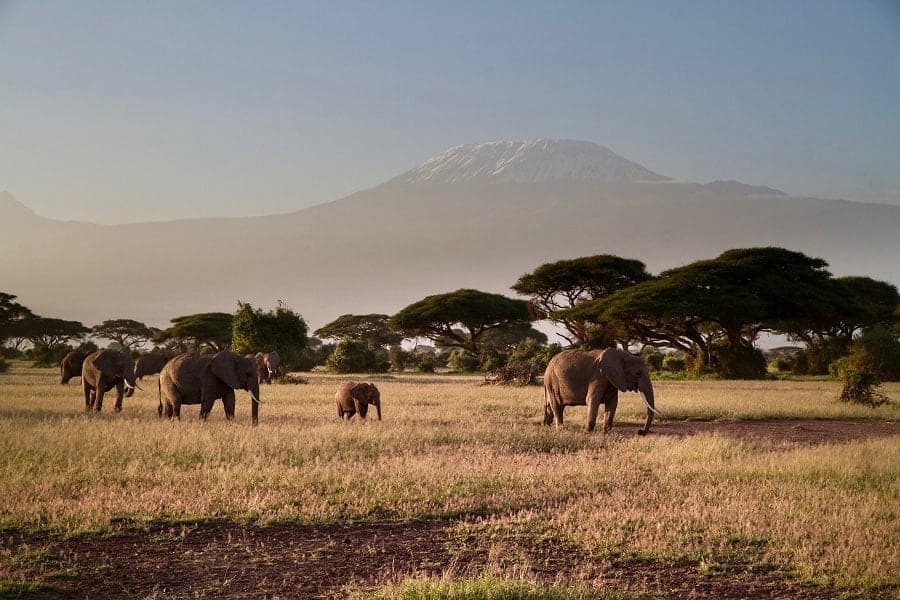
Elephants walk past the camp at sunrise. A herd of zebra skips around the river below. Hyenas cackle until a resonant lion roar echoes through the trees. This is African safari, an evocative immersion in the wild world , an intimate insight into a wilderness that hasn’t been tamed.
The best way to think about it is to consider the etymology of safari. It’s a Swahili word meaning “journey” and journey is the only adequate descriptive for the experience.
It’s a journey that connects you with your wild side , an experience that can only be understood after you’ve taken the plunge and visited Africa’s wildernesses.
What Makes Safari So Special
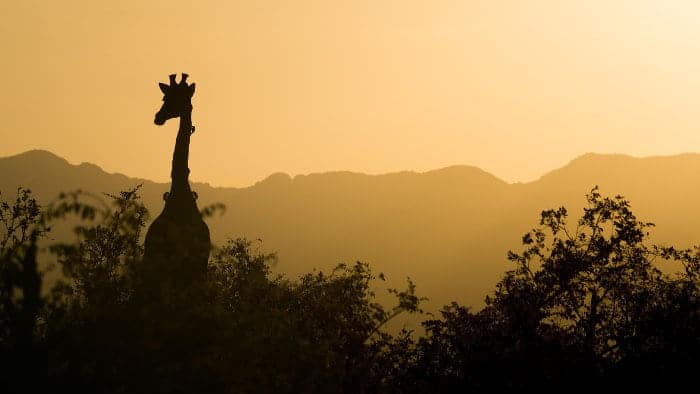
Africa and African safari are usually too challenging to preconceive . If you’ve been to Paris you can make a guess as to what Rome looks like. But it doesn’t matter how many wildlife documentaries you’ve seen, nothing can prepare for the feeling that exists in Africa’s great wildernesses .
A zoo is where a handful of animals are caged for the enjoyment of thousands of visitors. A safari is where you’re invited into the wildlife world , where you are amongst a handful of visitors admiring hundreds of thousands of wild animals.
Visit a zoo and you’ll see animals, perhaps even get a selfie with them. Go on a safari and the experience can’t be encapsulated in a single moment.
Every day brings an incalculable number of scenes and impressions : baboons shouting, leopard stalking, antelope grazing, buffalo charging, giraffe turned to silhouette at sunset.
So trying to compare a safari to a zoo is like confusing Paris’ Louvre with an elementary school art exhibition: sure, both are art, but they’re not the same.
Embracing the Immersion and Intimacy
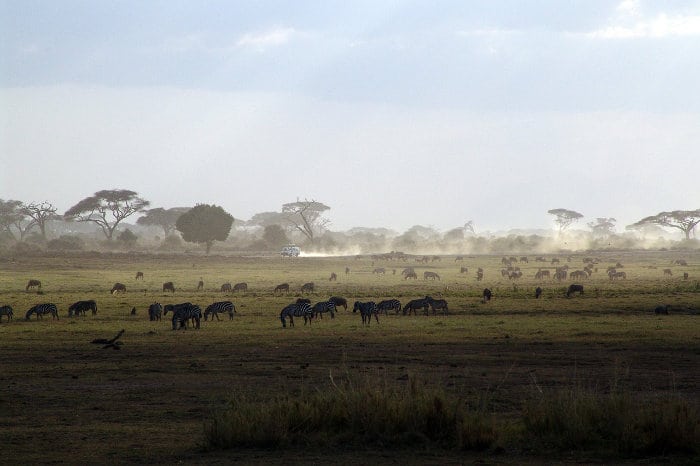
With an African safari you are completely immersed in the wilderness and the wildlife world. Through game drives and other activities you will really explore, but the experience is 24-7 . Nature sings a daily lullaby, exotic smells guide your journey, and you can be in awe of the landscapes even when there are no animals in the vista.
At a zoo you’re on the outside looking in. With a safari you’re in the heart of it all, surrounded in 360 degrees of wildlife drama. Seeing animals in their natural habitat is one part of the experience; waking up in the wild is another experience entirely.
This immersion is complemented by intimacy . You get close enough to hear the crunch of lions ripping apart a zebra carcass; glances are shared as an elephant bull looks you up and down; an endangered white rhino seems almost close enough to touch.
Often there is so much going on that everyone gets a different experience in the same place . For example, come across a herd of 2000 zebra and there are many micro scenes to find, not including a lone leopard hiding in the grass nearby.
Experiencing Both the Scale and the Detail
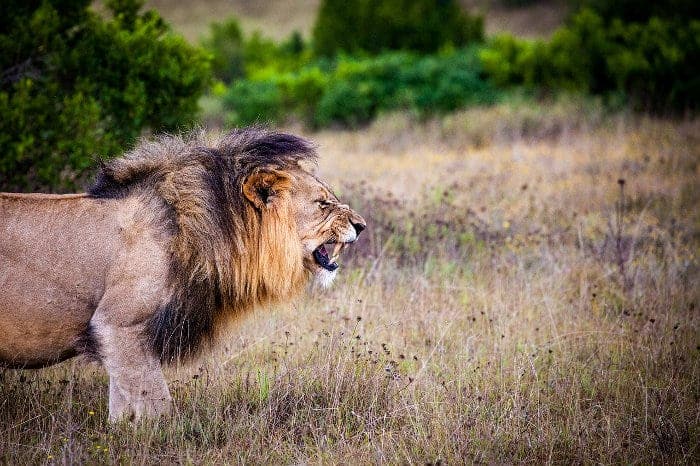
On a first-time safari it’s impossible to ignore the call of specific animals . You want to see lions, leopards, elephants, and all the famous characters endemic to Africa. There’s the big five of course and they’re often high on the list.
At first you’re enjoying redolent snapshots of single animals , taking in all the details on a micro level: a baby elephant chasing a warthog, a lion’s mane, hippos yawning in the water. The level of detail is remarkable and after the first two hours you’ll realise that there is always something new when you look the other way.
Even the smallest private game reserves are on a baffling scale. Some of the big national parks and reserves are larger than most European countries! Such enormous wildernesses provide home for huge animal populations .
Witnessing an elephant is a special experience; around 100,000 elephants can be seen in Botswana’s Chobe National Park . It can take three days just to cross Tanzania’s Serengeti , which is home to more than 2 million wild animals .
It’s this mix of scale and detail that has people coming back year after year for a safari.
But Really, What is an African Safari?

Safari isn’t just going to Africa to see some animals. It’s an opportunity to connect with your wild side and experience the natural world as it really is. But all that’s to come.
Where do you start when there are hundreds of different safari destinations and many distinctive ways to discover the landscape?
Although it’s possible to go on a half or full-day safari, especially if you’re staying in Cape Town, at Africa Freak we always recommend a multi-day safari experience . You’ll see more , feel more , and get a deeper sense of the wild world .
On a typical multi-day safari you’ll enjoy two specific activities each day , which usually maximise the times when animals are most active : early morning and late afternoon . There could be other activities after dark as well, or in big parks like the Masai Mara or Kruger you may spend the whole day exploring.
For the rest of the time you are still on safari. Even at the lodge or camp you’ll be listening to and watching the animals. In most destinations it’s worth the trip just to feel the landscape , before you even set eyes on any of its four-legged inhabitants.
Safari is a Journey

On a multi-day safari you’ll start to understand why safari is such a strong Swahili word. Safari really will take you on a journey as it helps to open up your wild side . With two or three days you can fully explore a single park or reserve, but we’d recommend much longer.
Every safari destination is different , with contrasting landscapes, animals and scenes. Spend a week and you could visit three or four different parks, building a more complete picture of Africa’s wild world.
Hey, if it was up to us we’d spend our whole lives on safari, experiencing all the beauty of the world’s final animal strongholds.
Just by reading this you’ve started the journey and we encourage you to continue. That wild side is ticking within you and there’s never a better time than now to start exploring. Remember, Africa is an enormous continent of 54 countries and over 1000 languages .
Every destination is a little different and suited to a different kind of visitor; you could have a private plunge pool overlooking the herds or a mobile camp hundreds of miles from civilization; for some, safari is sitting back and watching the wildlife roam past, while others want to be out discovering at all times of the day.
So explore the WHERE and learn about Africa’s safari destinations .
Read about WHEN to go on safari to maximise your experience.
Learn about WHO you’re going to meet on the journey, from communities and cultures to all the animals.
Discover HOW a safari day unfolds and get practical tips on making your safari an even better success.
See WHY safari is so important for conservation and self discovery.
And start planning your own safari in Africa .
- International edition
- Australia edition
- Europe edition

Tiger King’s ‘Doc’ Antle convicted of wildlife trafficking in Virginia
The Myrtle Beach Safari owner was accused of illegally buying endangered lion cubs for display and profit at his zoo
A wild animal trainer featured in the popular Netflix series Tiger King has been convicted of wildlife trafficking in Virginia, the attorney general’s office announced on Tuesday.
Bhagavan “Doc” Antle was accused of illegally buying endangered lion cubs in Frederick county, Virginia, for display and profit at his South Carolina zoo, Jason Miyares, the attorney general, said in a news release. A jury convicted Antle on Friday of two felony counts each of wildlife trafficking and conspiring to wildlife traffic.
Antle, who owns the Myrtle Beach Safari, appeared in Tiger King: Murder, Mayhem and Madness, a Netflix documentary miniseries that focused on tiger breeders.
The jury acquitted Antle of five counts of animal cruelty and Judge Alexander Iden dismissed four additional animal cruelty charges against Antle and all charges against his two adult daughters, the Winchester Star reported.
Prosecutor Michelle Welch said Myrtle Beach Safari’s lucrative petting zoo motivated Antle to maintain a steady supply of immature lion cubs that he purchased from Wilson’s Wild Animal Park near Winchester, calling the arrangement a “cub pipeline” from Virginia to South Carolina.
When Antle and Keith Wilson, the park’s former owner, began doing business in 2015, it was still legal to buy and sell lions, Welch said. But after lions were designated as an endangered species in December 2015, lions could only be traded between zoos and wildlife preserves that were part of an established breeding program and had permits. There were three illegal cub exchanges in 2017, 2018 and 2019, Welch said.
Antle was indicted in 2020 on several offenses including felony counts of wildlife trafficking and conspiracy. In August 2019, 119 animals – including lions, tigers, bears, camels, goats and water buffalo – were seized from Wilson’s roadside zoo after a judge found that Wilson “cruelly treated, neglected, or deprived” the animals of adequate care.
Wilson testified that Antle paid him in advance under the guise of a donation. He said Antle paid $2,500 to $3,000 for a cub with the exception of the 2017 transaction when Antle traded three lynx kittens for three lion cubs.
Wilson is charged with nine misdemeanor counts of animal cruelty and 10 felony counts of selling an endangered species and a hearing in his case is scheduled for Friday.
Defense attorney Erin Harrigan called Antle’s prosecution politically motivated in response to a growing public outcry against wild animals being exploited for entertainment purposes.
after newsletter promotion
“This has been an agenda in search of a crime from the beginning of the investigation,” Harrigan said.
Harrigan maintained that the cubs were gifts and Antle sent Wilson donations for an expanded tiger habitat.
“These were not sales,” Harrigan said.
Iden allowed Antle, who faces up to 20 years in prison, to remain free on bond pending sentencing on 14 September.
- South Carolina
Most viewed
- Share full article
Advertisement
Supported by
Doc Antle of ‘Tiger King’ Is Charged With Wildlife Trafficking
Mr. Antle’s daughters and a former roadside zoo owner in Virginia also face charges of animal cruelty.

By Christina Morales
The owner of an animal park featured in the Netflix documentary “Tiger King: Murder, Mayhem and Madness” has been charged with wildlife trafficking in connection with lion cubs moved between Virginia and South Carolina, prosecutors announced on Friday.
Bhagavan Antle, who is known as Doc and is the owner of Myrtle Beach Safari in South Carolina, was charged with two felony counts related to wildlife trafficking and 13 additional misdemeanors, according to the Office of the Attorney General of Virginia . Tawny Antle and Tilakam Watterson, daughters of Mr. Antle, are also facing several misdemeanor charges in connection with animal cruelty and alleged violations of the Endangered Species Act.
“I categorically deny any act or conduct that could ever be considered as ‘animal cruelty,’” Mr. Antle said in a statement. “I have spent my entire professional life promoting the welfare and conservation of big cats and other species.”
In March, as Americans were still getting used to being stuck at home because of the pandemic, Mr. Antle captured nationwide attention with memorable appearances in “Tiger King.” Millions of viewers were drawn to the documentary, which spotlighted the big business of big cats in America.
The man at the center of the documentary, Joseph Maldonado-Passage, known as Joe Exotic, is serving a 22-year sentence in federal prison for trying to hire a hit man to kill Carole Baskin , an animal-rights activist who runs Big Cat Rescue in Tampa, Fla.
Netflix declined to comment on the charges brought against Mr. Antle.
“We are thrilled to see law enforcement take action to stop what we believe to be illegal trade and illegal treatment of these innocent tiny cubs,” Howard Baskin, Ms. Baskin’s husband, said in an email.
The indictments were announced after a monthslong investigation by the Virginia attorney general’s animal law unit into the relationship between Mr. Antle and Keith A. Wilson, owner of Wilson’s Wild Animal Park in Frederick County, Va. Mr. Wilson was also charged with two felonies related to wildlife trafficking and 17 other misdemeanor charges.
Virginia prosecutors said the animal law unit had found that the men trafficked lion cubs between Virginia and South Carolina.
“Antle’s tiger mill has been the source of immense cruelty to hundreds of tigers and must be shut down,” Kitty Block, the president and chief executive of the Humane Society of the United States, said in a statement. “We know firsthand all about his treatment of animals.”
Last November, the Virginia attorney general, Mark R. Herring, announced that Mr. Wilson and his nephew Christian Dall’Acqua had both been indicted on 46 counts of animal cruelty by a grand jury in Frederick County. A trial date has been set for June 2021.
In August 2019, the animal law unit seized 119 animals from Mr. Wilson’s “roadside zoo,” prosecutors added in the statement, including lions, tigers, bears, camels, goats and water buffaloes. A 12-hour hearing about the seized animals showed inadequate conditions at Mr. Wilson’s animal park, prosecutors said.
“I have deep regard and feelings for the animals in my care and would never hurt or abuse them in any way,” Mr. Antle said in his statement. “I look forward to being able to answer these charges and be able to clear my good name.”
Christina Morales is a reporter covering national breaking news for the Express desk. She is also a member of the 2020-21 New York Times fellowship class. More about Christina Morales

An official website of the United States government
Here's how you know
Official websites use .gov A .gov website belongs to an official government organization in the United States.
Secure .gov websites use HTTPS A lock ( Lock A locked padlock ) or https:// means you’ve safely connected to the .gov website. Share sensitive information only on official, secure websites.
- The Attorney General
- Organizational Chart
- Budget & Performance
- Privacy Program
- Press Releases
- Photo Galleries
- Guidance Documents
- Publications
- Information for Victims in Large Cases
- Justice Manual
- Business and Contracts
- Why Justice ?
- DOJ Vacancies
- Legal Careers at DOJ
- About USAO-SC
Doc Antle, Owner of Myrtle Beach Safari, Pleads Guilty to Federal Wildlife Trafficking and Money Laundering Charges
WASHINGTON – Bhagavan “Doc” Antle, 63, of Myrtle Beach, S.C., pleaded guilty today to a conspiracy to violate the Lacey Act and a conspiracy to launder money.
Antle is the owner and operator of The Institute for Greatly Endangered and Rare Species (T.I.G.E.R.S.), also known as the Myrtle Beach Safari. The Myrtle Beach Safari is a 50-acre wildlife tropical preserve that offers tours and private encounters with exotic wildlife. Antle is also the Director of the Rare Species Fund, a nonprofit organization registered in South Carolina.
The Lacey Act prohibits trafficking of illegally taken wildlife, fish or plants, including animals protected under the Endangered Species Act. Antle conspired to violate the Lacey Act between Sept. 2018 and May 2020 by directing the sale or purchase of two cheetah cubs, two lion cubs, two tigers and one juvenile chimpanzee – all of which are protected under the Endangered Species Act. Antle used bulk cash payments to hide the transactions and falsified paperwork to show non-commercial transfers entirely within one state. Antle also requested that payments for endangered species be made to his nonprofit so they could appear as “donations.”
The investigation also uncovered evidence of money laundering between Feb. and April 2022, when Antle and a coconspirator conducted financial transactions with cash they believed was obtained from transporting and harboring illegal aliens. To conceal and disguise the nature of the illegal cash, Antle and his coconspirator would take the cash they received and deposit it into bank accounts they controlled. They would then write a check to the individual that had provided the cash after taking a 15% fee per transaction.
“The defendant held himself out as a conservationist, yet repeatedly violated laws protecting endangered animals and then tried to cover up those violations,” said Assistant Attorney General Todd Kim of the Justice Department’s Environment and Natural Resources Division (ENRD). “This prosecution demonstrates our commitment to combatting illegal trafficking, which threatens the survival of endangered animals.”
“The defendant’s guilty plea is a testament to the dedication and perseverance of the FBI and our law enforcement partners in combating illegal financial activities,” said Special Agent in Charge Steve Jensen of the FBI Columbia Field Office. “The FBI remains committed to upholding the integrity of our financial systems and ensuring justice is served.”
“Wildlife crime is often connected with other criminal activity, including money-laundering," said Assistant Director Edward Grace of the U.S. Fish and Wildlife Service, Office of Law Enforcement. “This investigation revealed a pattern of illicit wildlife transactions orchestrated by the defendant under the guise of donations and false paperwork. The Service and our partners will continue to hold accountable those involved in wildlife trafficking and other related crimes to ensure the future of all federally protected species. The Service will continue to bring to justice individuals who profit from the illegal trafficking of big cats and endangered species.”
“This plea is the product of exemplary collaboration between our law enforcement partners,” said U.S. Attorney Adair F. Boroughs for the District of South Carolina. “I commend our team for their work on this case who worked countless hours to unravel Antle’s sophisticated web of financial crimes and interstate wildlife trafficking. Our office remains committed to protecting endangered animals from those who would exploit them for profit.”
For each count, Antle faces a maximum penalty of five years in prison, a fine of up to $250,000 and three years of supervised release. U.S. District Judge Joseph Dawson III for the District of South Carolina accepted Antle’s guilty plea. He will sentence Antle after receiving and reviewing a sentencing report prepared by the U.S. Probation Office.
The FBI and the U.S. Fish and Wildlife Service are investigating the case. Senior Trial Attorney Patrick M. Duggan of ENRD’s Environmental Crimes Section and Assistant U.S. Attorney Amy Bower for the District of South Carolina are prosecuting the case.
Office of Public Affairs at 202-514-2007
Related Content
COLUMBIA, S.C. — A federal grand jury in Columbia returned a 15-count indictment against Christine Mary Livingston, 46, of Gaston, and Jerell Reaves, 33, for bribery, conspiracy, honest services wire...
CHARLESTON, S.C. — Richard Alexander “Alex” Murdaugh, 55, of Hampton, was sentenced to 40 years in prison for 22 federal financial crimes, including conspiracy to commit wire fraud and bank...
- &Beyond Connect
- My WILDwatch Online
- Chat to our WILDwatch guides at Ngala
- Chat to our WILDwatch guides at Phinda
- Chat to our our WILDchild guides
- Chat to our Conservation experts
- WILDwatch Live
- WILDchild TV
- Experiences TV
- Protect our planet
- Humans of &Beyond
- Engage: Inspiring People
- Explore: Travel Inspo
- Impact: Making a difference
- Indulge: Spoil yourself
- WILDwatch: The Animal World
- Meet the editor
- Africa @ home
- Asia @ home
- South America @ home
- WILDchild @ home
- &BEYOND LODGES
- South Africa
- Flying solo
- With my partner
- With my family
- Adventurous
- Responsible Travel
- Private Travel
- Slow Travel
- TRAVEL TRADE PORTAL
- MANAGE YOUR TRAVEL BOARD
- 3 years ago by Claire Trickett
90 words to use on your next safari
From aardvark to zebra, each grouping or ‘family’ of animals has its own collective noun….
A safari is at the top of many a bucket list. And for good reason. Whether it’s your first game drive or your 100th, each and every one is an adventure; a true broadening of horizons; an education for the mind; and a rejuvenation of the soul.
Fully kitted out in brand new khakis, with cameras and binoculars at the ready, wildlife and nature enthusiasts from around the world eagerly clamber up onto the rugged Landcruiser. Barely able to contain their childlike excitement, they embark on a safari into the unknown.
For the next few hours, or days, they will be captivated by nature’s beauty, mesmerised by the most fascinating facts and regaled with stories (and safari words) they’ll continue to tell their own friends and families for years to come.
While on a safari, you get to do things you’ve only ever dreamed of. Like listening to the grunting gnus of the Great Migration as they traverse the mighty plains of East Africa. Or riding a horse in the African wilderness alongside curious zebra and giraffe (image © Kaskazi Horse Safaris).
Perhaps you’ll take to the sky in a hot air balloon and float peacefully over the world-famous Mara River or the equally renowned Namib Desert. If you’re lucky, you’ll see the Big Five , perhaps catch a fleeting glimpse of one of the Elusive Eleven , or you might even witness a kill, like something straight out of a wildlife documentary.
Going on a safari with an expert &Beyond guide is like stepping into a real-life encyclopaedia that is filled with countless unexpected (and often unbelievable) facts about the most curious of creatures, both big and small.
You’ll learn all sorts of wildlife trivia, like how the chameleon changes colour, what makes the flamingo pink, why the dung beetle spends its day rolling around in dung, and why lions have black tufts on fur on their tails and the backs of their ears.
You’ll watch in awe as the golden orb spider effortlessly spins its silky, golden web. If you’re patient, you’ll likely see one or two of the Little Five , the pint-sized namesakes of their more widely known Big Five counterparts. You might even learn some age-old bush survival skills, like how to make a fire using sticks , or how to make a toothbrush out of a twig and toothpaste out of ash and water.
The more inquisitive and adventurous safari goers often end up doing things they never even thought imaginable, like sticking their fingers in (dry) elephant dung to determine the gentle giant’s diet or taking part in a highly competitive and always entertaining dung-spitting competition.
Yes, you read that correctly. Known as bokdrol spoeg in Afrikaans, this is the comical sport of spitting small, hard pellets of impala or giraffe dung. The farthest flung dung determines the overall dung-spitting champion. Don’t knock it until you’ve tried it! What happens on a safari, stays on safari.
Perhaps one of the most popular “safari classroom” lessons is the ever amusing collective noun discussion. Did you know that each grouping or ‘family’ of animals, from the tawny tiger and the leaping lemur, to the sluggish sloth and the hefty hippo, has its own, often rather charming, collective noun?
Here are 90 words to use on your next safari … or journey (after all, safari is the Swahili word for journey). Whether you’re exploring the plains of Africa, the jungles of Asia, or the timeless landscapes of South America, these safari words often weave their way into discussions amongst wildlife lovers. While some are bonafide terms widely accepted in the industry, some are just tongue-in-cheek and meant for a smile.
And if you’re looking for some expert advice (and a few more safari words), our Safari 101: a beginner’s guide sheds light on some more game drive lingo and how to get the most out of your luxury safari adventure.
As they say in Swahili, safari njema or have a good trip. Don’t forget to pack your sense of humour and a keenness for adventure, and join us for a dazzling journey [pun(s) intended].
1. An armoury of aardvarks 2. A colony of ants 3. A shrewdness of apes 4. A troop of baboons 5. A cloud of bats 6. A skulk or leash of bat-eared foxes 7. A sloth of bears 8. A hive of bees 9. A herd or obstinacy of buffaloes 10. A kaleidoscope of butterflies
11. A caravan of camels 12. A chain of caracals 13. An army of caterpillars 14. A glaring of cats 15. A coalition of cheetahs 16. A cartload of chimpanzees 17. A quiver of cobras 18. An intrusion of cockroaches 19. A consortium of crabs 20. A bask or float of crocodiles
21. A murder of crows 22. A pod of dolphins 23. A cluster or flight of dragonflies 24. A paddling of ducks 25. A herd of dugongs 26. A convocation of eagles 27. A herd, memory or parade of elephants 28. A school of fish 29. A flamboyance of flamingoes 30. A chorus or army of frogs
31. A gaggle of geese 32. A journey of giraffes (on the move) 33. A tower of giraffes (standing still) 34. A charm of goldfinches 35. A band of gorillas 36. A cloud of grasshoppers 37. A confusion of guinea fowl 38. An array of hedgehogs 39. A bloat of hippos 40. A colony of honey badgers
41. A charm of hummingbirds 42. A clan or cackle of hyenas 43. A mess of iguanas 44. A prowl or shadow of jaguars 45. A smack or brood of jellyfish 46. 47. A conspiracy of lemurs 47. A leap of leopards 48. A pride of lions 49. A lounge of lizards 50. A herd of llamas
51. A plague of locusts 52. A labour of moles 53. A business of mongooses 54. A swarm or scourge of mosquitoes 55. A consortium of octopus 56. A parliament of owls 57. A bamboo or embarrassment of pandas 58. A pandemonium of parrots 59. An ostentation of peacocks 60. A waddle or convent of penguins
61. A prickle of porcupines 62. A rhumba of rattlesnakes 63. An unkindness of ravens 64. A crash of rhinoceroses 65. A round of robins 66. A bed of scorpions 67. A sluthe of servals 68. A shiver of sharks 69. A stench of skunks 70. A bed or snuggle of sloths
71. A knot of snakes 72. A clutter of spiders 73. A scurry of squirrels 74. A murmuration of starlings 75. A fever of stingrays 76. A streak or ambush of tigers 77. A knot of toads 78. A bale of turtles 79. A posse of vicuñas 80. A venue or committee of vultures
81. A kettle of vultures (when flying overhead) 82. A boil of vultures (when coming down to land) 83. A sounder of warthogs 84. A pack of wild dogs 85. A litter of wild dog pups 86. A confusion of wildebeest 87. A dazzle of zebras
And, finally, just for a laugh…
88. A safari of people 89. An ingratitude of children 90. A randy of rangers (as coined by the late Bob Griffin, a dear friend of &Beyond )
NB: there is no official collective noun for pangolins because they are solitary; some say predicament; I prefer perfection.
SEE WHAT LIES BEYOND
Subscribe to the Bateleur Magazine.
You might also be interested in…
Leaving our world a better place for years, discover the impact legacy that your travel with &beyond is driving. just as the un’s sustainable development goals have been a touchstone for our vision 2020 group-operation sustainability audits, so they continue to guide and underpin our ambitiously scaled vision 2030 goals., we're sorry but this site doesn't work properly without javascript enabled., please enable it to continue., privacy overview.
- More from M-W
- To save this word, you'll need to log in. Log In
Definition of safari
Examples of safari in a sentence.
These examples are programmatically compiled from various online sources to illustrate current usage of the word 'safari.' Any opinions expressed in the examples do not represent those of Merriam-Webster or its editors. Send us feedback about these examples.
Word History
Swahili, journey, from Arabic safarī of a journey
1859, in the meaning defined at sense 1
Phrases Containing safari
- safari jacket
- safari park
- safari suit
Dictionary Entries Near safari
Cite this entry.
“Safari.” Merriam-Webster.com Dictionary , Merriam-Webster, https://www.merriam-webster.com/dictionary/safari. Accessed 27 Apr. 2024.
Kids Definition
Kids definition of safari, more from merriam-webster on safari.
Thesaurus: All synonyms and antonyms for safari
Nglish: Translation of safari for Spanish Speakers
Britannica.com: Encyclopedia article about safari
Subscribe to America's largest dictionary and get thousands more definitions and advanced search—ad free!

Can you solve 4 words at once?
Word of the day.
See Definitions and Examples »
Get Word of the Day daily email!
Popular in Grammar & Usage
More commonly misspelled words, commonly misspelled words, how to use em dashes (—), en dashes (–) , and hyphens (-), absent letters that are heard anyway, how to use accents and diacritical marks, popular in wordplay, the words of the week - apr. 26, 9 superb owl words, 'gaslighting,' 'woke,' 'democracy,' and other top lookups, 10 words for lesser-known games and sports, your favorite band is in the dictionary, games & quizzes.

Serengeti's Great Migration: the world's ultimate wildlife spectacle
Nov 1, 2021 • 14 min read
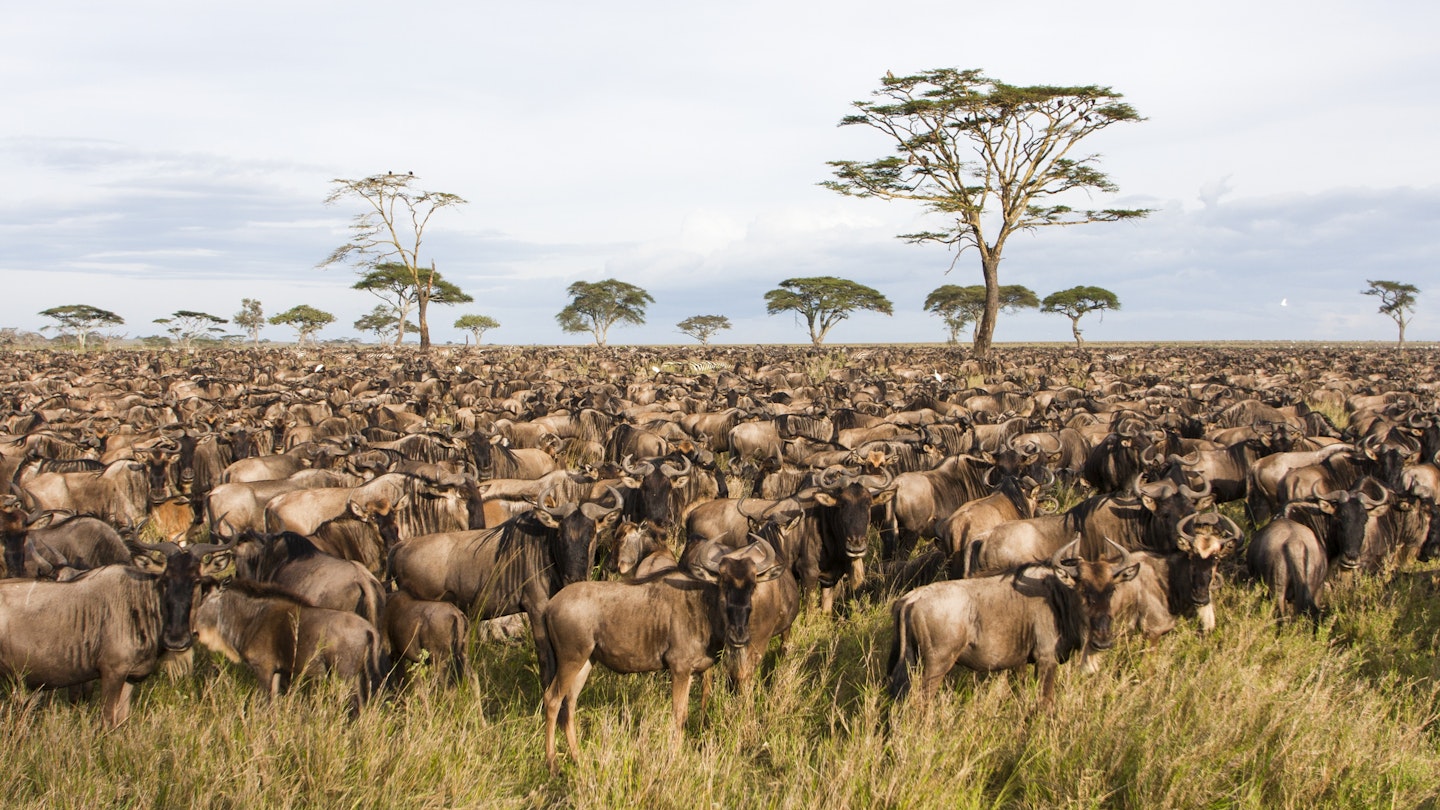
Serengeti National Park, Tanzania © PHOTOSTOCK-ISRAEL / SCIENCE PHOTO LIBRARY / Getty Images
Often billed as the world’s ultimate wildlife spectacle, the Great Migration of wildebeest and zebra takes place annually across the plains of East Africa ; Amanda Canning travels to Tanzania to try to catch up with the herds.
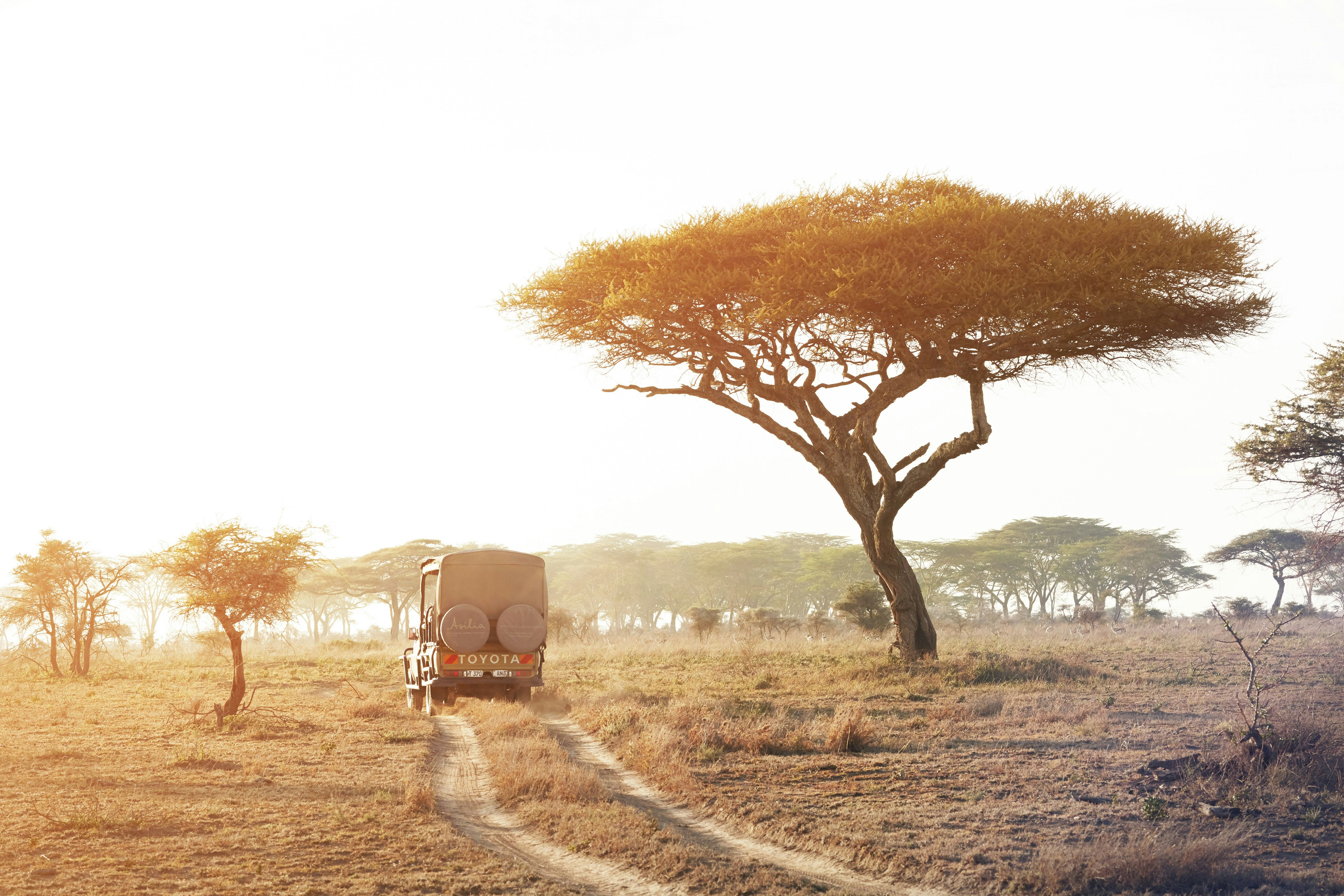
First day on safari: slow gnus day
It’s been an excellent night for the predators of the Serengeti . As the sun starts to inch over the horizon and casts a pale light over the acacia-pocked plains, it reveals a scene of nocturnal carnage. There are bones here, bones over there, bones everywhere. White bones picked clean and dazzling as if fashioned from porcelain; scrappy, dirty bones, bits of unidentifiable flesh still clinging to them; bones that retain the shape of the animal from whence they came.
Above it all, vultures wheel through the sky or sit hunched in acacias, occasionally floating down to earth to better inspect a kill, looking every bit as sinister as one might hope from their villainous, cartoon reputation. A good number of the night’s revelers are still out, enjoying the last bits of the feast before heading home for a day’s solid napping.
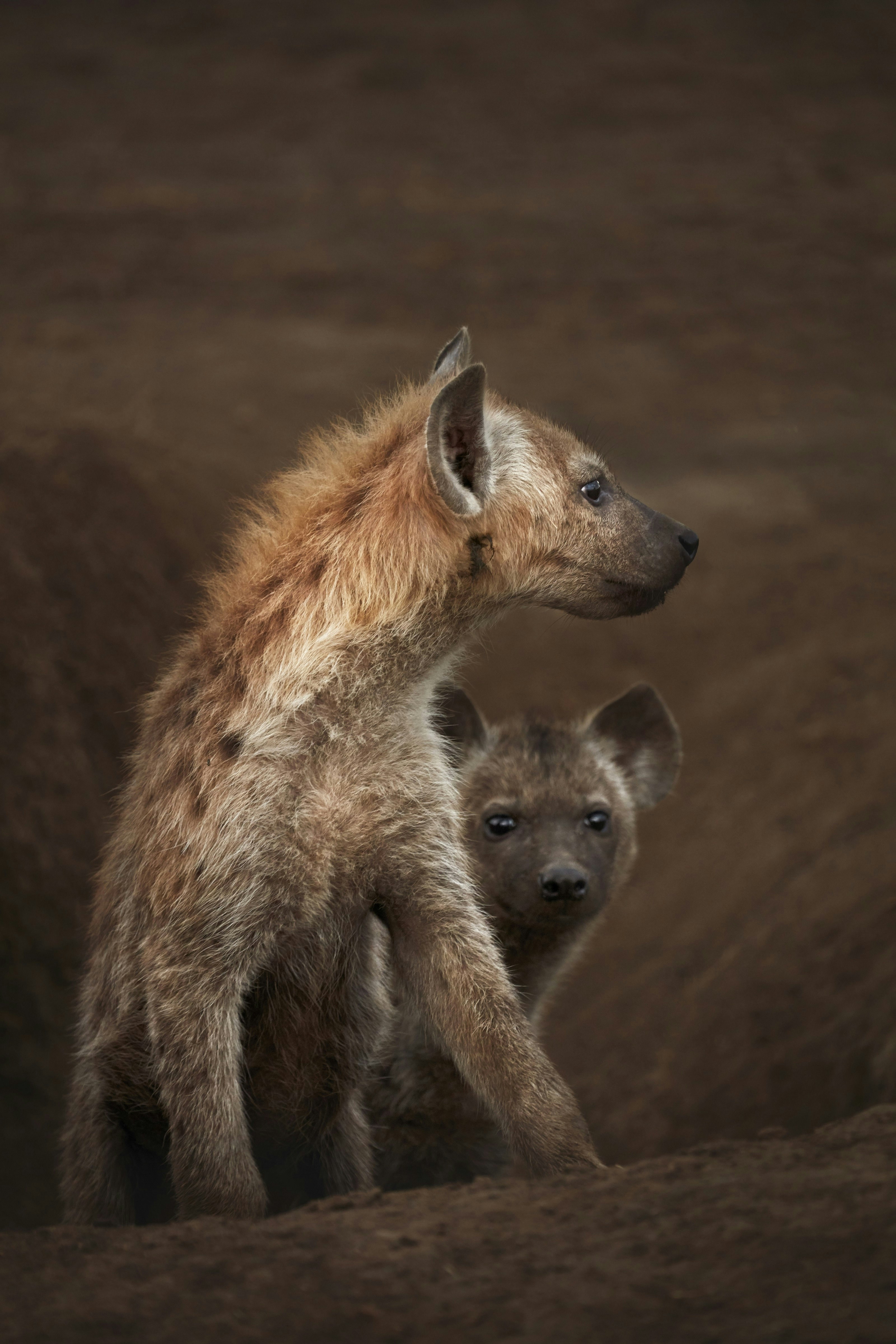
We’ve not long left our camp on the Namiri Plains before my guide Noel Akyoo spots a flurry of activity in the distance and bumps the Land Cruiser in its direction. A hyena trots past, the back legs of a Thomson’s gazelle dangling from its jaws. Beyond him, a group of around 20 hyenas is gathered around the rapidly disintegrating carcass of a wildebeest, some plastered in blood up to their shoulders. They break into a fight, squabbling over a prime piece of meat, before continuing to feed in a riot of chattering and whooping. A pair of jackals sits nearby in eager anticipation, not brave enough to move in, too hungry to move on. In a tree behind them, a tawny eagle pulls at a rib held in its yellow talons.
The Serengeti’s predators don’t always have it this good. I’ve timed my visit to coincide with the Great Migration, the annual 1,200-mile journey of 1.5 million wildebeest and 250,000 zebra between Tanzania and Kenya , following the rains and the grasses that spring up in their wake. The season is bonanza time for any creature that counts them as dinner – for the lions, cheetahs, leopards, hyenas and wild dogs here, hunting at this time of year requires as much effort as picking a dish from the conveyor belt at Yo! Sushi. It must be, I assume, fairly easy for a human to track down the migrants too.
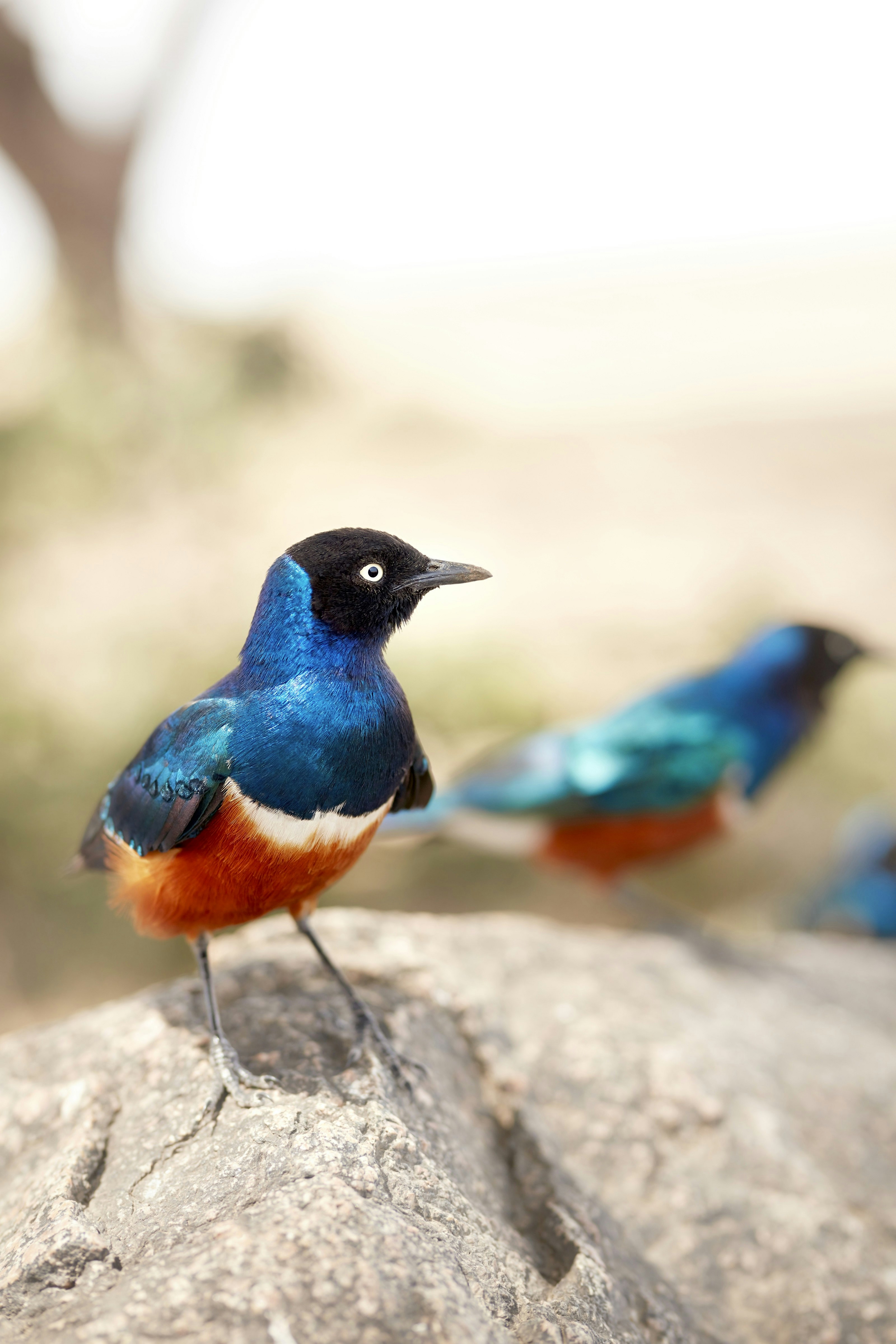
I am wrong. There is plenty of evidence of deceased wildebeest, and small living clumps of them idling about or plodding to some unseen destination across the plains, but I expected to be overwhelmed by thousands upon thousands of the beasts, thundering past in clouds of dust.
Where you should go on your first safari in Africa
Noel moves the Land Cruiser off and we trundle along rutted tracks. "We will try and find them," he says, "but the migration was early this year. The herds are already moving south to give birth in the woodlands." He laughs. "That is the beauty of the Serengeti – you never know what you’re going to come across." What we do come across on that first day is extraordinary enough. There are the wonders of animals not generally on people’s wildlife checklists: the bright flashes of superb starlings come to investigate what we are; a long-horned beetle slowly eating a yellow fever tree from the inside out; the pointy ears of a caracal hiding (badly) in the long grass. And there are the big-hitters too.

The Namiri Plains is known for its cheetahs, at one point off-limits to visitors for over 20 years in an effort to increase their numbers. We spot several through the day, their long, thin bodies stretched out in the dust or pulled upright on termite mounds, alert to the hint of prey. There is an embarrassment of lions too, lolling about in the grass or cooling themselves on the rocks, tiny cubs tumbling about like furry drunks as the pride males consolidate their standing as the rock stars of the savannah, manes billowing in the wind and backlit by the setting sun.
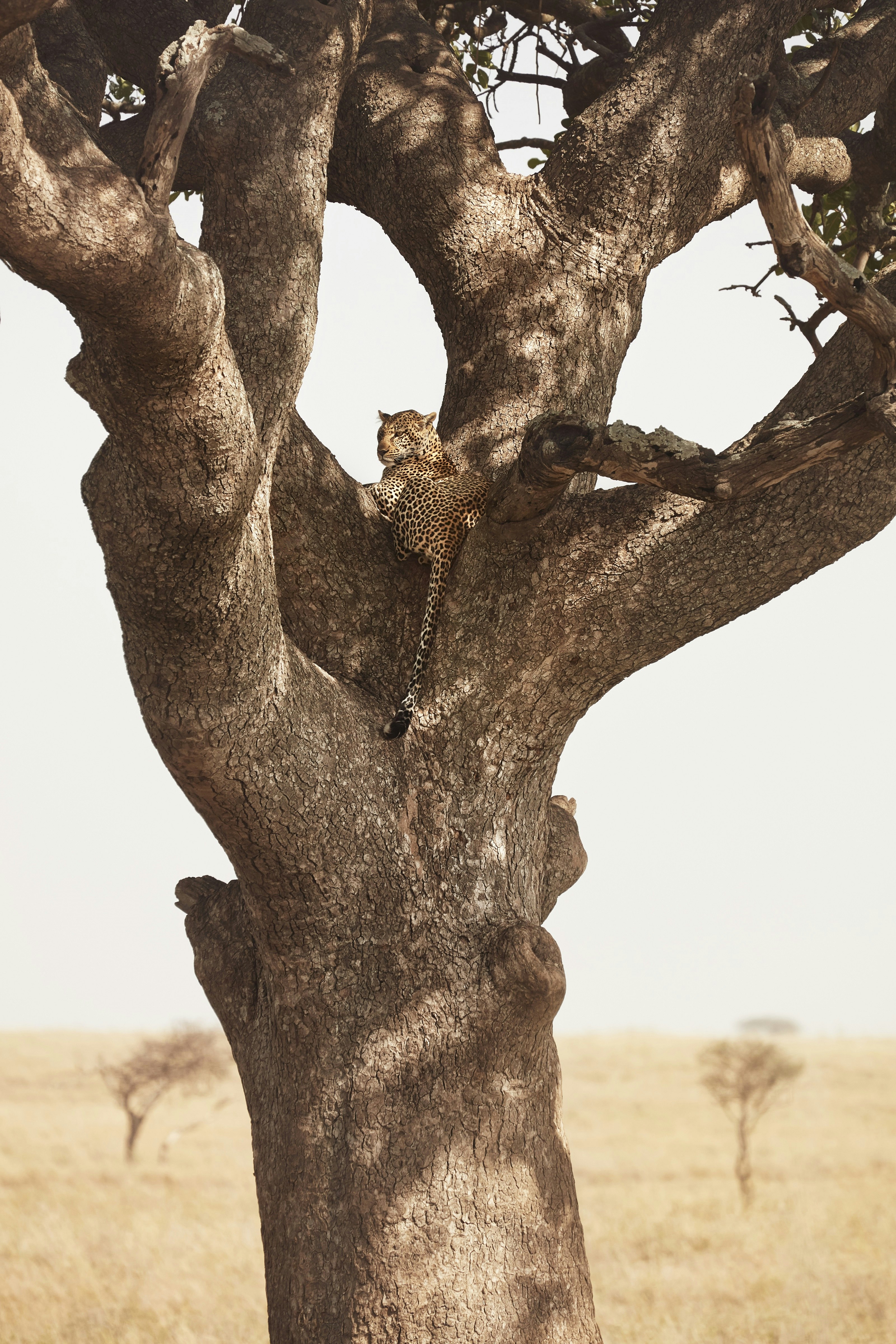
We have the rare privilege of spotting a leopard, too, an elegant female tucked into the crook of a tree, her long tail twitching against the trunk. Returning to camp, though, I can’t help but be nagged by the somewhat ungrateful thought that the trip represents the only chance in my lifetime to experience one of the world’s greatest wildlife spectacles, and it’s happening somewhere else. Noel is unconcerned. "Every day is different," he says, clambering out of the vehicle. "There is always tomorrow."
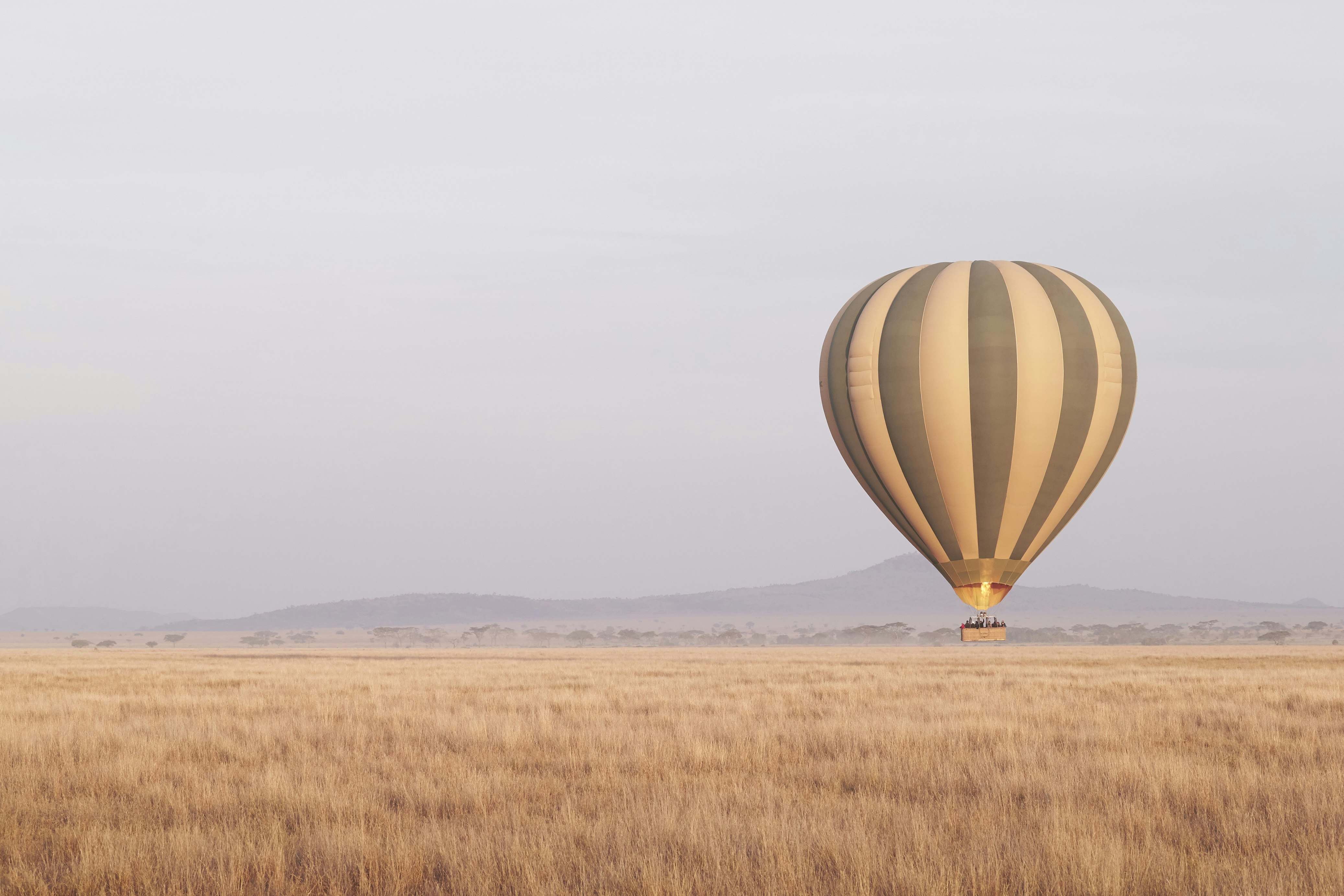
Second day on safari: hot-air balloon over the Serengeti
The day starts beneath a billion stars. I am standing outside my tent, watching as two shoot across the inky sky when the deep guttural rumble of a lion reverberates through the darkness. It is likely some way off, down by the river bordering the camp, but it is a sound of such primordial resonance, my entire body seems to vibrate to it.
With dawn approaching, the lion’s time to hunt is over: it’s my turn to take on a shift. The day has brought a change in tack: if we can’t find the migration from the ground, perhaps we’ll have better luck from the sky.
The story of lions (and your guide on where to see them on safari)
The last stars are fading as our hot-air balloon slides into the sky. For the first few minutes, we skim across the ground, past trotting warthogs and strutting ostrich, then suddenly we are a hundred meters up, with all of the Serengeti stretched out beneath us. It is a vast beige sea, dotted with acacias and granite outcrops. The Seronera River wiggles through it, the shiny lumps of a hippo pod visible in its shallows.

Pulling on the burner, captain Mohamed Masud studies the ground beneath us. "You can see how busy this area gets in migration time," he says. "There are so many trails." The earth looks scratched, there are countless pale lines cut into it, rift into the ground by millions of hooves passing this way for a million years. There is little sign of the herds this morning though. "We don’t really know where they are now," continues Mohamed. "The rain has not come so the migration is really spread out. Maybe if it rains, it will come."
A day on safari in Africa: what you can expect in camp and in the wild
The grazing animals that live in this patch of the Serengeti year-round are out in force. Giraffes bob across the savannah, galloping for cover on gangly legs as we sail overhead, their unexpected arrival into woodland marked by the alarmed calls of ibis and morning doves. As I peer after them, I spy several groups of animals standing unmoving among the trees: wildebeest. Not thousands, not thundering past in clouds of dust – but wildebeest all the same.
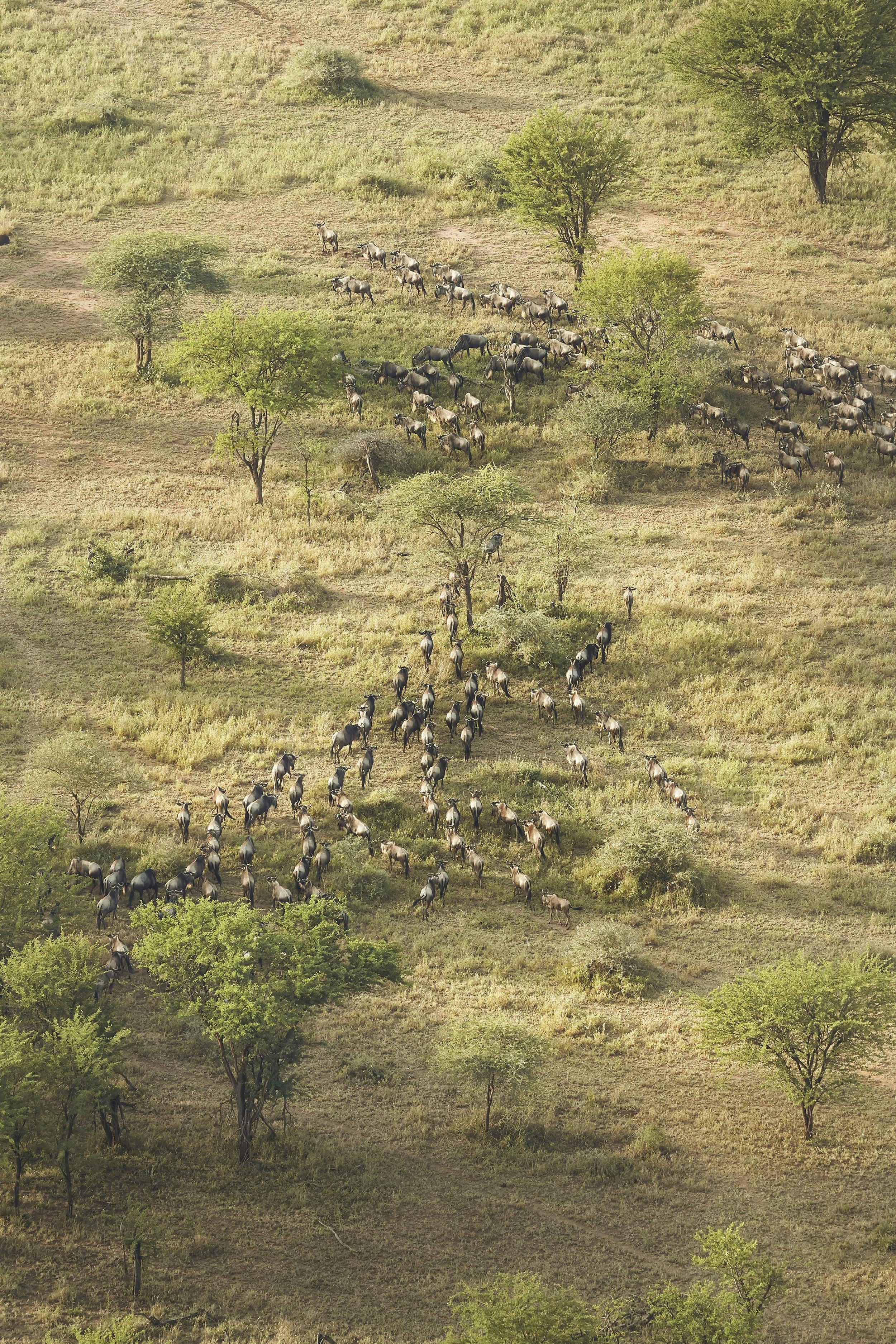
Back on the ground, we head towards the woods and almost immediately catch up with our target. A long line of several hundred wildebeest is plodding towards the river. They need to cross a road to join the huddles I’d seen from the balloon, but none seems willing to make the first move. "The thing about wildebeest," says Noel, "is that they don’t have a leader. If the one in front changes direction, they all follow." We watch as they make slow comedic progress towards their goal. One animal bolts, and a hundred animals bolt. One stops, and they all stop. One starts heading back the way it came, and within minutes, the entire herd has spun around. It takes a good two hours of confused milling before they finally muster up the courage to cross.
As we lurch back to camp, triumphant after the first, small taste of the migration, I turn and take a last look at the herd: behind them, fat, dark clouds are starting to bubble on the horizon. The rains are coming.
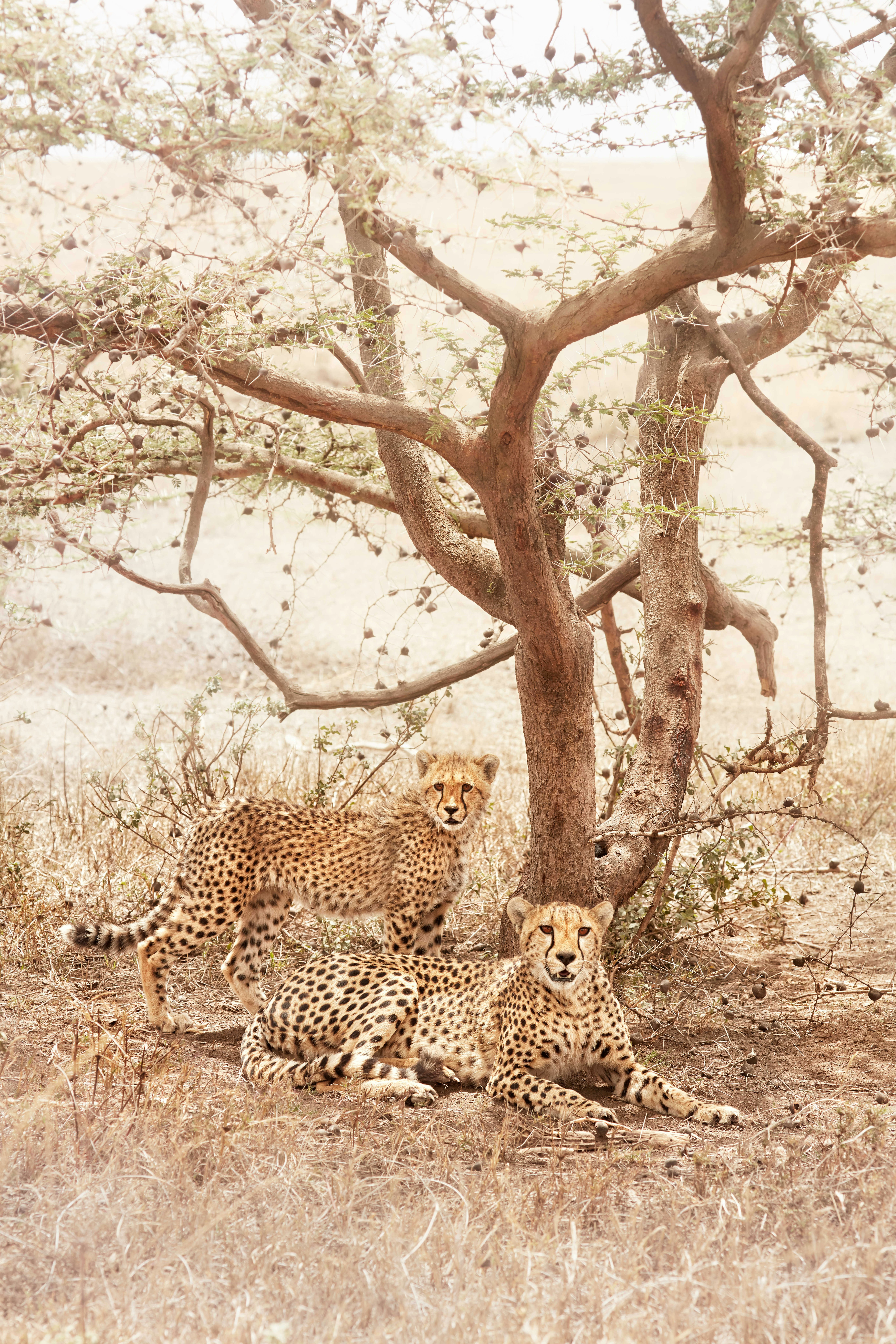
Third day on safari: cheetahs hunting on the Serengeti plains
If the migration is heading south, then so must we. It’s a short bounce in a light aircraft to the next camp in the southern Serengeti. From the air, it’s clear we’re catching up with the wildebeest: far below, innumerable black dots are moving steadily in the same direction as we are.
From the airstrip, my guide Charles Joseph takes us straight off to a herd he’s been following for a few days. Many thousand wildebeest, the odd zebra mingled among them, are plowing across the plains, a huge billowing cloud of dust rising overhead. The line is so long we can’t see the front or end of it. "This group has been moving back and forth for nearly a week," says Charles. "They’re looking for water."
We are not the only ones watching. All around them, predators lurk, waiting for night. There is one creature that needs not the cover of darkness to mount an attack. Across the plains, Charles spies a cheetah and her cub sheltering behind a whistling thorn acacia. The mother is restless and apparently hungry. "Cheetahs are right down the pecking order of predators," says Charles, as large globs of rain start to splatter into the dust around us. "They can’t compete with a lion or a wild dog, so their only advantage is to hunt in daytime."
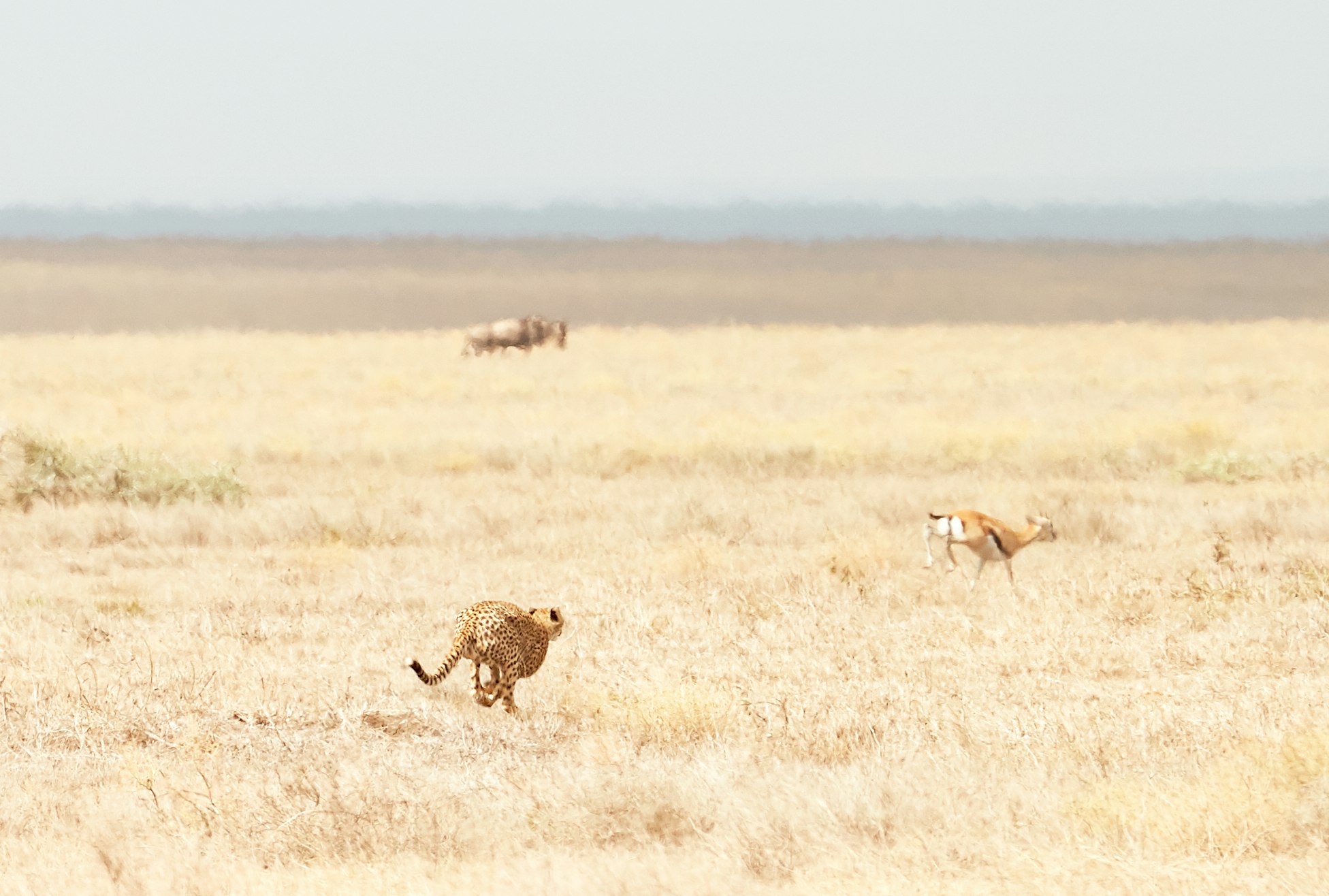
We spend the next few hours tracking the mother as she locks sight on her prey, readies to attack, and is then spotted and her plan thwarted. Soon the savannah is a vast soggy field, and the cheetah is perfectly camouflaged within it. Still, every gazelle seems wise to her approach. She has traveled several miles before she gets her chance. Hunkering down in long grass, she waits for two gazelles to approach. They walk past her, oblivious, and she does not move. Just as I imagine she’s missed her chance, she is off and after them in an explosion of force. Within 20 seconds, one gazelle is down. The mother and cub take it in turns to feed, one constantly watching out for scavengers. "You can’t relax for a second out here," says Charles as three vultures land nearby. "The hyenas won’t be long. They’ll have seen the vultures circling and will follow."
Their luck holds, however; the only creatures that come to join the party are dung beetles, which whirr in from all directions and have a marvelous time in the gazelle’s bowel. The cheetahs leave only the head and bladder intact. "The hyenas will have that," says Charles. "They don’t really care what they eat." I’ve been so transfixed that it’s only when the pair drop full-bellied into the grass that I become aware of the life now brimming on the plains: there are thousands upon thousands of wildebeest, behind, in front, to the side, trudging ever on.
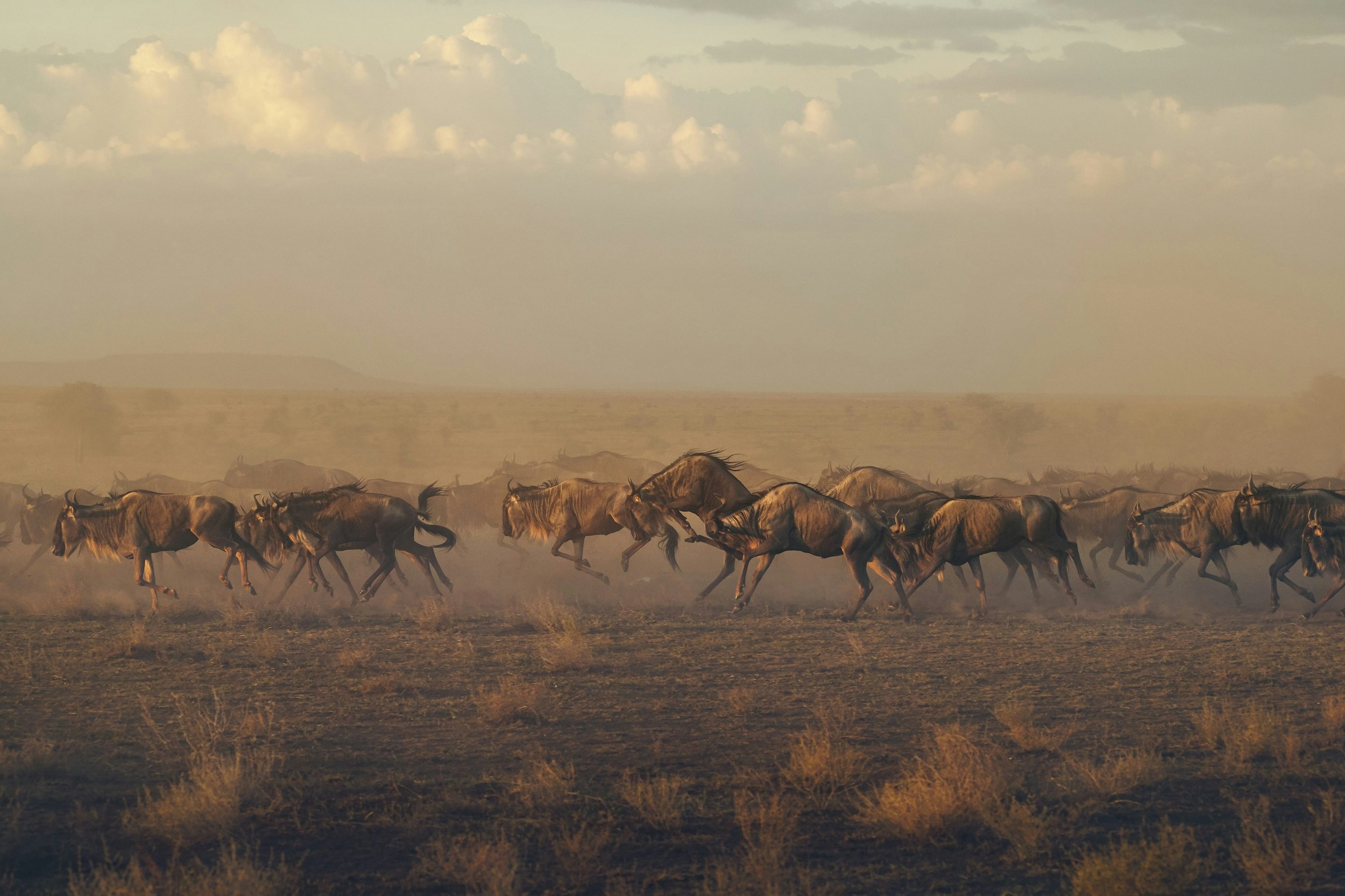
Fourth day on safari: wild dogs and death on the Great Migration
Overnight, our camp has become a motorway for the migration. I could spend the day in bed and watch it pass meters away, but we decide to head further south, where they’ve had more rain, to try to catch the rest of the herds.
We drive for a few hours, crest the Maru Hills – and there before us is the Promised Land for grazing creatures. There is not an inch of the earth not occupied by one. Gnus and zebra stand grunting, resting in the shade of trees or splashing about in rivers. Baboons sit and pick at each other’s fur. Elephants roam, hosing their hides with water from their trunks. The grass is green and long, the fruit on the trees plentiful and ripe. If I were a wildebeest, I’d walk a thousand miles for this too.
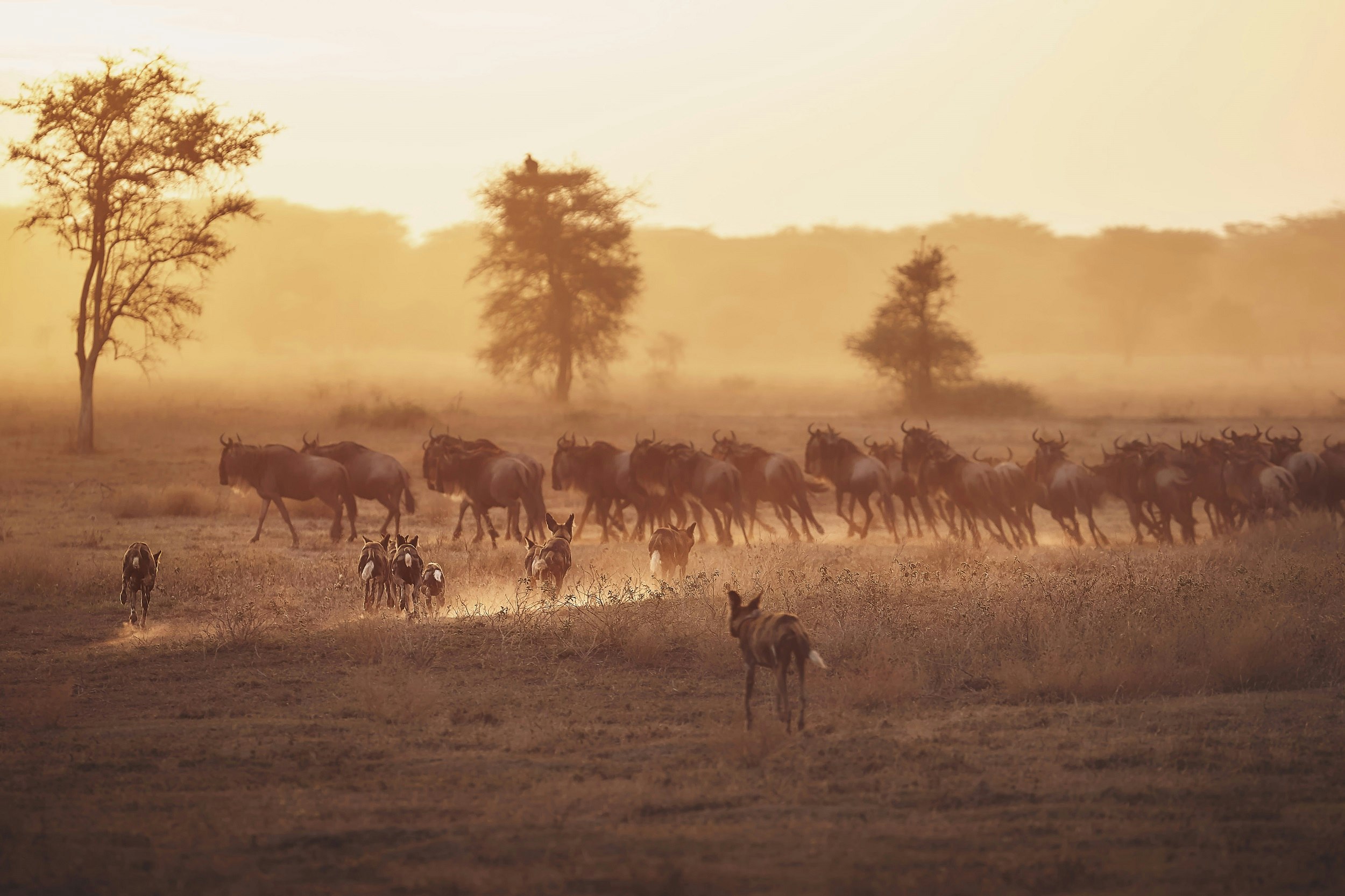
Returning home in the warm glow of the setting sun and the satisfaction of a mission accomplished, we’re drawn to a commotion close to camp. Thousands of wildebeest are stampeding, and we soon see why: wild dogs. A pack is herding the animals into groups, assessing which to target. It’s a world of confusion: dust flying, legs kicking, prey grunting, predators barking, and the rumble of hooves like a drum beat to it all.
And then the Serengeti pulls off the world’s greatest magic trick and makes the entire scene disappear. We sit in silence in the murk, the dust slowly settling around us. A bark comes in from the left, and off we go. When we rejoin the hunt, it’s apparent the pack has marked its prey: a juvenile is being forced out of the herd. "They’re super hunters, one of the best predators in the world," says Charles. "Once they have made a decision to hunt, they do not stop until they have their kill."
The wildebeest is done for. A dog gets hold of its leg and pulls it down. The pack is upon it in a frenzy, wary that a lion might turn up and make off with the spoils. It takes an excruciatingly long time for the animal to die. It’s still alive and trying to get up as one dog runs off with its liver and another its intestines.
I return, queasily, to camp to find the wildebeest and zebra still passing through. It is a steadying sight, the timelessness of the endeavor brought into sharper focus after the macabre events of the last hour. Naturally, the animals are marching solemnly in the opposite direction they had been that morning. They may know where they’re going, but they’re not going to get there any time soon.
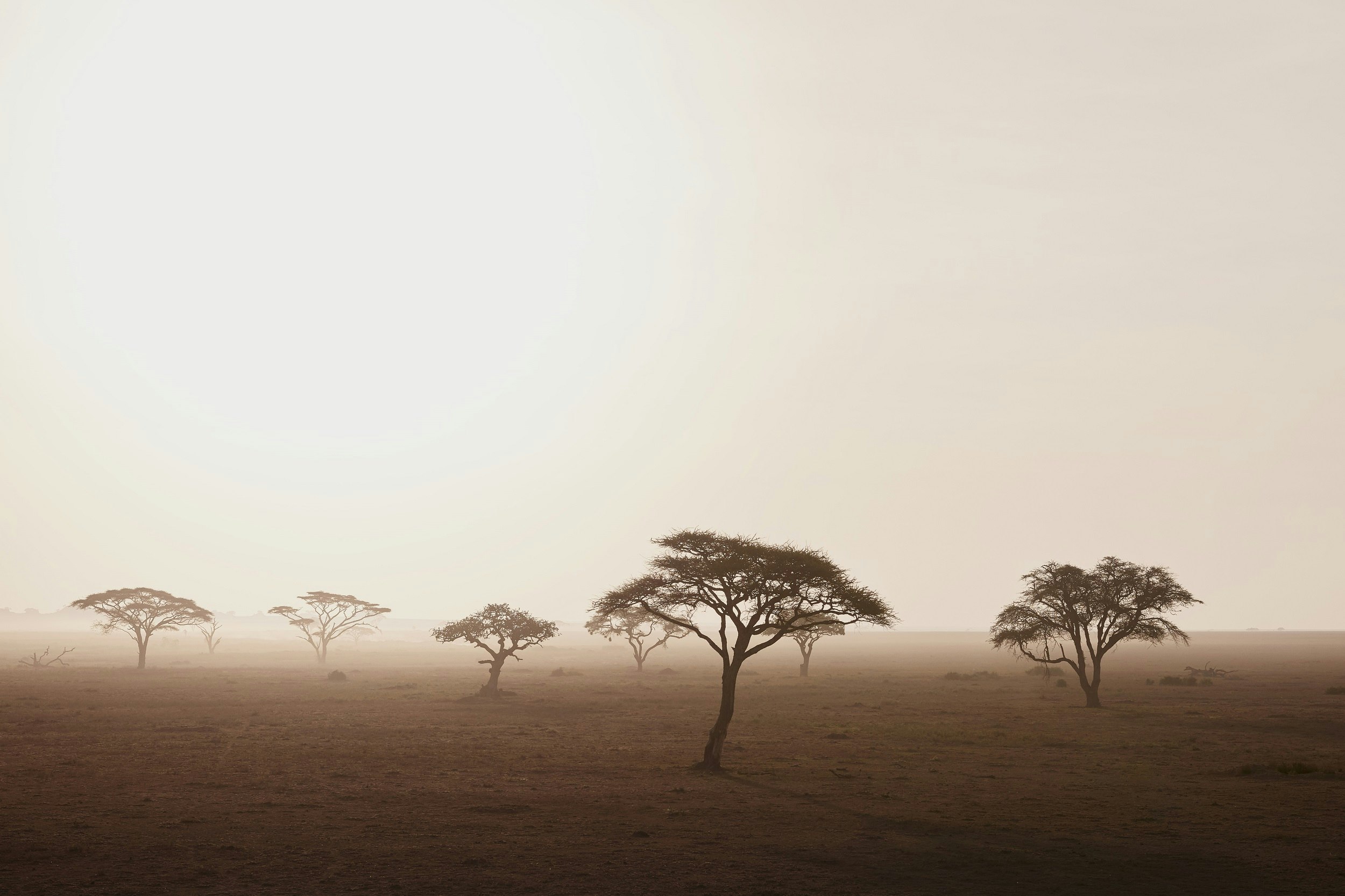
When to go on Great Migration safari in the Serengeti
The animals follow the same path each year, traipsing back and forth between the Serengeti in Tanzania and the Masai Mara in Kenya. The migration does not follow a strict schedule, however, and its precise location in any one month cannot be guaranteed. Factors such as an early or late rainy season will affect when the 1.5 million wildebeest and 250,000 zebra start to move. If you’re booking well ahead, it’s wise to go with a tour operator or camp who is able to change your itinerary depending on the herds’ progress. The below is a rough guide only.
January to March: Grazing and calving in the southern Serengeti April to May: Herds start to move north, passing through the central Serengeti June to August: Cross the crocodile- and hippo-infested Mara River and head into the Masai Mara September to October: Grazing in the Masai Mara November to December: Return south, and the cycle begins again
Need to know
- Check ahead with the US Embassy in Tanzania for the latest updates regarding COVID-19 testing and vaccine requirements.
- You’ll need an up-to-date yellow fever vaccination to enter Tanzania. Don’t forget to bring your certificate – you’ll need to show it at the airport on arrival.
- You’ll want a course of anti-malarial drugs to cover your stay, and to bring mosquito repellent. If you don’t like DEET-based or other chemical repellents, we’ve found the natural, citronella versions effective (and considerably less stinky).
- The plains can be dusty, particularly on windy days. Bring a light scarf or Buff to cover your face. You’ll want a jumper or jacket for cooler morning game drives.
- Your guide will have a pair of binoculars they’ll likely let you borrow, but it’s worth bringing your own. A pair with 8x or 10x magnification will do the trick.
- Don’t bring bright or patterned clothing that will make you stand out to all animals within a mile radius; plain grey, green or beige clothes are best.
Getting to the Serengeti
It’s a two-stop hop to the Serengeti; you’ll likely fly via Nairobi or Amsterdam on your way to Kilimanjaro International Airport in Tanzania; from there, catch a light aircraft to one of the region’s airstrips. Your lodge will advise which one is most convenient.
Getting around the Serengeti
Light aircraft act as buses in the Serengeti, picking people up from one part of the park and depositing them elsewhere, likely with stops on the way for other passengers. Lodges will arrange to collect you from the airstrip
Amanda Canning traveled to Tanzania with support from Audley Travel . Lonely Planet contributors do not accept freebies in exchange for positive coverage.
You might also like: Zimbabwe’s rising star Travelling to Africa with my young daughters: a father’s story Why seeing chimpanzees is one of the world's greatest wildlife experiences
This article was first published November 2019 and updated November 2021
Explore related stories

Jun 16, 2020 • 7 min read
A look back at some of the friendships made during 12 years of Lonely Planet magazine.

Apr 25, 2024 • 7 min read

Feb 20, 2024 • 17 min read

Feb 12, 2024 • 10 min read

Jan 30, 2024 • 19 min read

Jan 5, 2024 • 20 min read

Jan 2, 2024 • 11 min read
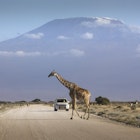
Dec 13, 2023 • 9 min read

Nov 30, 2023 • 9 min read

Nov 26, 2023 • 7 min read
- ALL MOSCOW TOURS
- Getting Russian Visa
- Top 10 Reasons To Go
- Things To Do In Moscow
- Sheremetyevo Airport
- Domodedovo Airport
- Vnukovo Airport
- Airports Transfer
- Layover in Moscow
- Best Moscow Hotels
- Best Moscow Hostels
- Art in Moscow
- Moscow Theatres
- Moscow Parks
- Free Attractions
- Walking Routes
- Sports in Moscow
- Shopping in Moscow
- The Moscow Metro
- Moscow Public Transport
- Taxi in Moscow
- Driving in Moscow
- Moscow Maps & Traffic
- Facts about Moscow – City Factsheet
- Expat Communities
- Groceries in Moscow
- Healthcare in Moscow
- Blogs about Moscow
- Flat Rentals
Moscow parks – leisure, nature and historical
Moscow is the most green megapolis in the world. There are over a hundred parks and green spaces like gardens, squares and boulevards. You will definitely bump into a few of them wherever you go. Whether you are interested in memorial, historic parks, parks of wildlife or you just want to have a calm break from the speedy city life – city parks have something special for everyone.
Moscow leisure parks
The leisure Moscow parks are undoubtedly the most popular and famous with the locals and travelers. Today such parks provide a great number of exciting entertainments for Muscovites and city guests, adults and children.
The Gorky Park

Gorky Park opened in 1928 and was the first holiday park in the Soviet Union with playgrounds, a sports stadium, exhibition halls and attractions for kids. Today it has a fresh, vibrant appearance. The park features bike rental stations, a comfortable business area with Wi-Fi, an outdoor movie theatre and a greenhouse where you can buy fresh greens such as basil and lettuce. To contemplate the sky and the stars, go to the observatory and look through the telescope while listening to fascinating stories from astronomers. Enjoy many sports in the park: volleyball, handball, football or a peaceful jog around the beautiful surroundings.

Zaryadye Park
Opened in September 2017, Zaryadye is the youngest on our list. Located just a few minutes away from Red Square, it includes various activities like the floating bridge with its thin V-form extension, an ice cave, also concert hall and an amphitheater. The entire territory of the park was divided into four zones of Russia: forest, steppe, tundra, and the floodplains.
Neskuchny Sad

By walking along the Moskva River’s bank from the Gorky Park towards Vorobievy Gory (Sparrow Hills) you’ll reach Neskuchny Sad («Not Boring» garden), a wonderful place in the Moscow center, one of Moscow’s oldest parks, charming slice of wildlife. The park mostly consists of pristine forest, dotted with old summer pavilions, ponds and quaint little stone bridges. There are a lot of opportunities for different activities lots of children playground, a ping-pong and chess clubs, football fields and tennis courts, horse riding, tree climbing and having rest in one of the nice cafes.
Museon Park

Hermitage Garden

Hermitage Garden has always been known as an amusement, entertainment center with theatres, shows, cafes, summer pavilions, pergolas since 1830. Shalyapin, Sobinov, Nezhdanova – great Russian opera singers starred on the garden stage. Famous Russian composer Rakhmaninov conducted the orchestra. Sara Bernar, Maria Yermolova, outstanding actresses, played in the open air performances. Tolstoy and Lenin had a stroll in the garden. So lots of celebrities from different epoques liked it a lot and spent their time in Hermitage Garden. You can find here three theatres in the garden: Hermitage, Sphere and New Opera. During winter an ice rink works here and in summer a musical stage is assembled to host jazz and brass band festivals.

In Sokolniki Park visitors can play billiard, chess or draughts, table tennis, as well as go cycling, roller blading and swimming in the summer and ice skating or skiing in winter. Each season is highlighted by special memorable and bright events, for example, Summer Jazz Festival or Baby Fest (for future mums), open air beach disco parties, Ice Cream Day, International Clown Festival and many other shows and exhibitions. The park has an observatory, kids center and a co-working zone with free Wi-Fi which is really nice for spending high quality work time there.

Moscow nature parks
The nature parks are national reserves with the amazing forestry and incredible variety of animals and plants there. The breath of wildlife and the chance to be closer to the virgin nature excites both children and grownups. Hundreds of different species of animals can be found in Moscow nature parks. The richest woodlands with old and even ancient trees, like a 200 years pine-tree in the Elk Island National Nature Park, are the point of passionate interest for visitors.
Aptekarsky Ogorod

Aptekarsky Ogorod (Apothecary Garden)
Aptekarsky Ogorod (Apothecary Garden) is one of the oldest gardens in Moscow. It was founded in the XVIII century by Peter the First (great Russian emperor). A larch that he planted himself still grows in the garden, so it’s more than 250 years old. At the time of its foundation, it was a garden with herbs and medicinal plants and was used as an educational center for doctors. Today there are the orangery with its tropical palms, the carp pond, and the immense trees that dot the landscape and turn wonderful golden shades in the autumn. Several restaurants and cafes work here making it a very nice spot for relaxation no matter what season it is. You can book a special tour or join the guided excursion group.
Losiny Ostrov

Losiny Ostrov (Elk Island Park)
Losiny Ostrov (Elk Island Park) is located at the north of Moscow. It covers 22 km from the west to the east and 10 km from the north to the south and it’s one of the most beautiful national parks in Moscow. Two rivers, Yausa and Pechorka begin here. You can find lots of fields, ponds, meadows, streams in the park as well as elks. Here you can enjoy guided tours, available in English. You can choose a guided tour about flora and fauna of the area, you’ll learn why elks are there, which animals are their neighbors. Or enjoy another excursion, which is totally devoted to historical past of ancient tribes once lived there, you’ll know about old Russian mythology, rituals and traditions.
Serebyany Bor

Serebyany Bor (Silver Forest)
Serebyany Bor (Silver Forest) is a famous pine forest in the west of Moscow. The park has 230 forms of plant life, and is also home to watersports complex, providing a lot of activities for visitors. The layout of Serebryany Bor is unusual, as it is located on an artificial island between a meander in the Moscow River and a channel. There is an artificial lake, the Deep Gulf and picturesque Bezdonnoe (Bottomless) Lake in the depths of the forest. Serebryany Bor’s beaches are the cleanest in the city and very popular among Muscovites. On weekends it is difficult to find a free spot here, especially because a whole range of services are offered to visitors, from simple deckchairs to catamaran and yacht rides. Driving is prohibited on the territory of the island so be ready to use trolleybus to reach the entrance.
Botanichesky Sad

Greenhouse of Botanical Garden
Main Botanical Garden of The Russian Academy of Sciences is the largest and most famous is Moscow. The garden is a real museum of nature with a very rich (more than 18000 types) collection of plants. The park was founded in 1945 at the place of the 17th century Apothecaries’ Gardens. The garden’s collection is turned into botanical expositions, made with use of modern receptions of landscape architecture. Here you can see a tree nursery, a shadow garden, hothouse complex, collection of flowers, a rosary, exposition of coastal plants, garden of continuous blossoming, Japanese garden and expositions of cultural plants and natural flora plants. The biggest part of Garden is the Tree nursery occupying the space of 75 hectares. About 2 thousand wood plants grow here. Another big exposition of the Garden is nature Flora, divided into six botanic-geographical collections: European part of Russia, Caucuses, Central Asia, Siberia and Far East. Pride of the Main Botanical Garden is the collection of tropical, coastal and water plants, which is considered as the best in Europe. The Japanese garden, a great model of Japanese landscape gardening art has a 13-level stone pagoda of the 18th century, stone Japanese lamps, ponds, falls and streams, tea lodges and more than 100 species of the most character Japan plants. It is especially decorative in spring, during Oriental cherry blossoming and in fall, when foliage blazes in crimson colors.
Moscow historic parks
Historic nature parks and estates once were the mansions of the Moscow aristocracy. At that far times the estates were outside the Moscow city limits, but after the city expansion and urbanization, they became easily accessible.
Kolomenskoye

Kolomenskoye Museum and Park
The chief attraction of the park is undoubtedly the stone Church of the Ascension of the Lord. It was constructed in 1532 by order of Tsar Vasily III to commemorate the birth of his son and heir, Ivan the Terrible. But there is a lot more to see in the park: the pretty Church of the Icon of Our Lady of Kazan – with its bright azure domes and plenty of gold. Further into the park there is a charming Church of the Beheading of St John the Baptist, built by Ivan the Terrible to mark his coronation.

Kuskovo Park
Kuskovo Park is one of the oldest country estates in Moscow. It was given to General Sheremetev by Peter the Great in 1715, but was left to fall into neglect before being plundered by Napoleon’s troops in 1812. Nowadays the estate has been restored to its former glory and is a good example of Russian 18th Century imperial architecture. The palace is a fine and rare example of wooden neoclassicism. It was completed in 1775, and the rich interiors remain unchanged since 1779. It includes a room hung with exclusive exquisite Flemish tapestries, an abundance of silk wallpaper and an impressive collection of 18th century European and Russian paintings. The palace looks onto the lake, which is surrounded by smaller pavilions: pretty Italian, Dutch and Swiss Cottages, Blank’s Hermitage and the old Orangery, where the State Ceramics Museum is located now, an extensive and absorbing collection of porcelain from the 18th century to the present day. On the other side of the lake is a large wood popular with local cyclists and joggers.
Our Private Tours in Moscow
Moscow metro & stalin skyscrapers private tour, moscow art & design private tour, soviet moscow historical & heritage private tour, gastronomic moscow private tour, «day two» moscow private tour, layover in moscow tailor-made private tour, whole day in moscow private tour, all-in-one moscow essential private tour, tour guide jobs →.
Every year we host more and more private tours in English, Russian and other languages for travelers from all over the world. They need best service, amazing stories and deep history knowledge. If you want to become our guide, please write us.
Contact Info
+7 495 166-72-69
119019 Moscow, Russia, Filippovskiy per. 7, 1
Mon - Sun 10.00 - 18.00


1423 Ward Rd Sequim, WA 98382
SPRING HOURS:
Open 7 days a week M - Su 9 a.m. to 4p.m.
Open all major holidays except Thanksgiving and Christmas Days .
Have a Question? Call Us! 360-683-4295
Commonly asked questions.
Since the 1940s, Olympic Game Farm in Sequim, WA has been dedicated to the welfare and well-being of animals. As a drive-through wildlife exhibit, we are entirely funded by tourists and are a fun place to experience wildlife at your own pace. We strive to be a source of wildlife education for families and tourists!
Letter from Robert Beebe, President
With over 200 animals on-site , our driving tour leaves our visitors with vivid memories of these amazing creatures; experiences which, at first are hard to imagine, become pleasantly surprising. Friendly llamas and yak eat bread from your hand, clowning bears stand up and wave, and the elk and buffalo peacefully graze in the pastures.
Olympic Game Farm worked exclusively for Walt Disney Studios for 28 years, filming here at the farm and on the Olympic Peninsula, as well as on many different set locations. A few popular titles produced with our past animal actors are “Charlie the Lonesome Cougar,” “The Incredible Journey,” “White Wilderness,” and “Grizzly Adams” television and movie series. In 2012, we had used our black bear “Kitty” and wolf “Brutus” in “Serenity Farms”. In winter of 2013, we used “Kitty” once again in a National Geographic documentary on black bear in the city. Summer of 2014, “Leland” a black tail deer was used in the filming of “Captain Fantastic” as well as Olympic Game Farm used as a filming location for a scene.
After the death of Walt and Roy Disney, Disney Studios began to move away from the nature films that had been so dear to Walt’s heart. In 1972, with the approval of the Disney Studios for using the Disney name, Olympic Game Farm, Inc. was opened to the public. Our founders Lloyd and Catherine Beebe retired from the filming industry and focused solely on caring for their animal actors, concentrating on offering “in need” captive bred animals a new and loving home. Olympic Game Farm will continue to accept in-need wildlife, as space permits and with the proper authority approvals. We cannot accept local animals from the wild without proper permission from Washington State Fish and Wildlife.
Lloyd Beebe passed along his trait, his dedication, and his love for wildlife to his grandsons Robert Beebe and James Beebe, along with their uncle Kenneth Beebe, who have taken over the daily operations of the Olympic Game Farm since 2008.
Thank you for your interest,
Robert L. Beebe
President, OGF
Recognitions
We won the Wildlife Conservation of the Year award in 1996 from the Washington Association of Conservation Districts (WACD). Lloyd and Catherine Beebe and Olympic Game Farm were honored through a Senate Resolution 8612 on January 20, 2011. Lloyd Beebe won Filmdom’s Famous Five’s 1960 from Film Daily.

Are pets allowed inside our vehicle while driving?
Yes, pets are allowed as long as they are kept inside an enclosed vehicle and unable to escape your vehicle. All pets must be on a leash when outside the vehicle in permitted areas.
Why was the game farm started?
In the 1950’s to 1972, Olympic Game Farm (then called Disney’s Wild Animal Ranch) was originally designed as a holding facility for the animal actors of Disney Studios. During breaks from filming, the animals were trained, housed, and cared for while waiting for future filming. Disney Studios had asked us to keep the public and cameras out of the Farm.

However, in the summer of 1972 after Roy Disney’s passing, we allowed people in to see what the Farm was all about. This informal opening was also a test to see if we could achieve our long-term goals in caring for the animals without a steady income from Disney Studios—to see if we could make it on our own. After that summer, we let Disney Studios know how well we did. Disney Studios ultimately held a vote from their Board of Directors and decided it was ok to continue to be open to the public and retain any earnings received. That same year, we officially opened to the public as a private wildlife organization and became incorporated in 1973.
Where do the animals come from?
Several of the animals are either rehomed, come as overflow from other licensed facilities, or have been received from other properly licensed individuals.
How do you afford to feed them?
Currently, all proceeds from tourism are put into animal care and feeding. This includes all operating costs (employees, licensing, feed, utilities, repairs, etc.) associated with caring for our animals. In the past, filmmaking and tourism was the mainstay; however, as the years and societal attitudes have evolved the film industry genre, live animal actors are no longer in high demand. We do receive donations from the local dairy farms and equestrians, or from a farm hobbyist. Income made from the summer season carries the Farm through the lean winter months. This presents tough budgeting constraints and is a tremendous struggle each year.
Do you accept random donations?
Yes, the Olympic Game Farm does accept any reasonable donations. Naturally, the best donation is monetarily, but we will consider all other types.
Are you open year round?
Olympic Game Farm is open year round but will be closed on Thanksgiving Day and Christmas Day in order to spend time with our families.
Do the animals come out during the rain or snow?
Yes, most if not all the animals are accustomed to our Northwest weather. All the animals have their own shelters and privacy areas if they need.
When is the best time to view the animals?
We always suggest mornings to early afternoons to be the best times, as most of our animals tend to lounge in the later afternoon times and take naps.
What is the difference between a wildlife park and a game farm?
A wildlife park/zoo is usually publicly funded by city, county, and/or state funds or a group of investors. Game farms are usually in connection with commerce, such as breeding, selling, or trading and are privately funded by the owners. Some game farms are associated with “canned” hunting but Olympic Game Farm does not practice this. In our case, “Game Farm” denotes that there are game animals located and housed here but not for hunting.
Are the animals at the Game Farm still used by the movie industry?
We have used a few of our current animals in several films, “Serenity Farms,” “Captain Fantastic,” and a National Geographic documentary on black bears and city encroachment. However, we are not actively seeking animal work in the film industry.
How long does the tour take?
Typical drive tour takes anywhere from 45 minutes to 1 hour but it is completely self-paced. The admission ticket is good for all day until closing. On major holiday weekends, wait times and lines can and do occur, thus extending drive tour time.
Are we allowed to bring our own bread to feed?
No outside bread at this time. Throughout the year (depending on the season) other food items will be available for purchase. This is at our discretion . Specific days, food items and other information will be available upon arrival.
Why can’t we bring in fruit or other food items to feed the animals?
You can donate fresh fruit, fresh vegetables, or fresh-caught fish to Olympic Game Farm but U.S.D.A. (APHIS) has a strict rule about customers feeding our animals. Wheat bread is the ONLY type of feed allowed to be given by the customers. Olympic Game Farm will accept fresh fruit and fresh vegetables but it will need to be inspected by us and fed out by us or under strict observation if permitted by senior management. Bread has been proven to be an excellent source of fat and fiber for our animals. Large animals differ from humans and domesticated animals tremendously, with their fat & nutritional needs. Rotten, moldy, or freezer dried items will not be accepted. We cannot accept anything from your personal freezer. Please call and check first about any other food items.
What other type of feed is given to the animals besides bread?
Each animal has a well-balanced nutritional diet based on their nutritional needs by our veterinarian care plan. Meat, poultry, fish, nuts, berries, vegetables, fruit, roots, vitamins, minerals, hay, & grain are fed daily, during business hours and after closing.
We do ask for customers to not take it upon themselves to decide what is best to feed our animals. Any food items other than the bread brought to feed will be held at the gate until the tour is over and it will be returned. Violators will be asked to leave.
We ask this, not only because of the U.S.D.A. rule, but also because each animal is carefully monitored and fed daily. Some of the animals are not allowed certain foods due to medical reasons, dental problems, allergies, being strict carnivores, etc.
For the best interest of our animals, it is important only wheat or whole grain bread from the Game Farm is fed to them. Produce or meat could make the animals sick.
Are convertibles/open vehicles permitted?
All vehicles must be fully enclosed at all times for your safety. Jeeps, Broncos, etc. must have sides and tops on, making it fully enclosed. NO MOTORCYCLES, SCOOTERS, MOPEDS, OR BICYCLES ARE PERMITTED on drive tour.
Can R.V’S or buses drive through the farm?
Yes. We have a delegated road for larger vehicle. The only animals you will not see are the prairie dogs and sika deer.
What was the difference between the original walk tour and the new “Mini Tour”?
The difference between the original walk and the new mini-tour is: • In the original tour, a tour guide would walk visitors through the predator area in addition to the barn and aquarium and was only offered to groups of 10 people or more when scheduled in advance at an additional charge. • In the “mini-tour,” all visitors can enjoy the experience at their own leisure but the predator compound is not included as this area is included in our driving tour.
When are the busiest times? Or what times/days to avoid long lines and traffic congestion inside OGF?
PLEASE plan your trip to Olympic Game Farm prior to your arrival here.
The busiest weekends are Memorial Day weekend and Labor Day weekend. Friday, Saturday, and Sunday are the busiest days of those two holiday weekends. Saturday and Sunday can see over 500 cars each day with peak times from ranging from 11 a.m. to 4-5 p.m. Traffic congestion throughout the Farm is always a concern during this time and we ask that all visitors be conscious and courteous to other visitors who are also trying to enjoy themselves as they drive around the Farm. Remember, your receipt is good all day until closing so that you can go around multiple times as needed. Also, our animals do get tired towards the afternoon/evening and can/will start to ignore people as the day wears on.
On a typical summer week, Saturday would be the busiest day and slowly tapers to the lowest day of Wednesday, then building back up each day. Beginning from 11 a.m., the peak traffic begins and eventually lessens after 3 p.m. as the animals grow tired and head to their sleeping areas for the evening.
Our employees do work as fast as possible to keep the entry traffic lines moving smoothly and quickly; however, the lines move as fast as our patrons allow us to work. We encourage that our visitors already have family plans/arrangements (such as who is paying and with what form of payment, also to know the ages of children, any discounts, etc.) made prior to entering the Farm.
Have questions about the history of our farm or admission ? Contact us today at (360) 683-4295 and we will be happy to help
Visitors, please note:.
Farm hours for the Spring effective February 19th 2024.
Hours are from 9:00 a.m. to 4:00 p.m Monday – Sunday
We ask visitors to arrive NO LATER than 45 mins before closing time to ensure entry and have time to fully enjoy the park.
The Farm, on occasion, does close for inclement snowy weather. Please be sure to call ahead to speak with a team member and ensure that we are open. Thank you, stay safe!!
Effective June 5, 2020 In compliance to U.S.D.A federal regulation 4.12.4 NO OUTSIDE BREAD PERMITTED. NO EXCEPTIONS. THIS IS PERMANENTLY IN EFFECT. Bread can be purchased onsite, and we will limit bread purchases as needed and appropriate. Anyone sneaking in and feeding outside bread or other food items will be asked to leave with no refund.
NO RESERVATIONS ARE REQUIRED. WE OPERATE ON A FIRST COME FIRST SERVE BASIS. TICKETS SALES ARE ONSITE AT THE TICKET OFFICE UPON ARRIVAL (NO ONLINE TICKET SALES) Cash or card payments only, we do not accept Apple Pay.
We are looking forward to your visit!
2018 Primetime Emmy & James Beard Award Winner
R&K Insider
Join our newsletter to get exclusives on where our correspondents travel, what they eat, where they stay. Free to sign up.
A History of Moscow in 13 Dishes
Featured city guides.

The Comprehensive Guide to Moscow Nightlife
- Posted on April 14, 2018 July 26, 2018
- by Kings of Russia
- 8 minute read
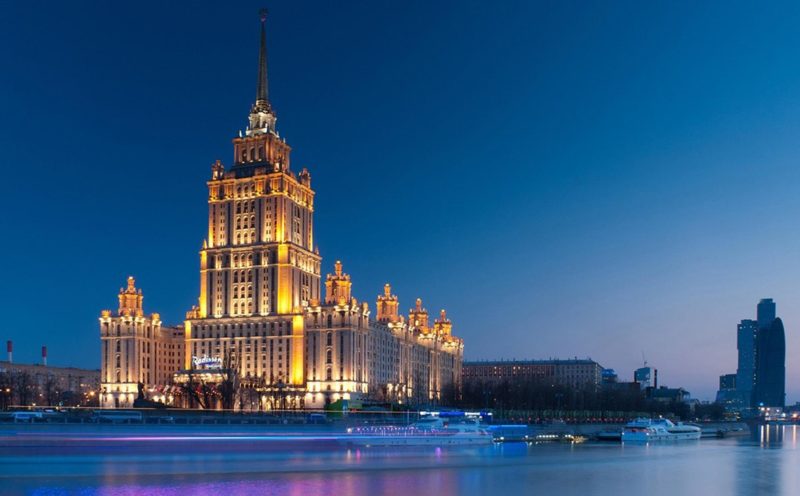
Moscow’s nightlife scene is thriving, and arguably one of the best the world has to offer – top-notch Russian women, coupled with a never-ending list of venues, Moscow has a little bit of something for everyone’s taste. Moscow nightlife is not for the faint of heart – and if you’re coming, you better be ready to go Friday and Saturday night into the early morning.
This comprehensive guide to Moscow nightlife will run you through the nuts and bolts of all you need to know about Moscow’s nightclubs and give you a solid blueprint to operate with during your time in Moscow.
What you need to know before hitting Moscow nightclubs
Prices in moscow nightlife.
Before you head out and start gaming all the sexy Moscow girls , we have to talk money first. Bring plenty because in Moscow you can never bring a big enough bankroll. Remember, you’re the man so making a fuzz of not paying a drink here or there will not go down well.
Luckily most Moscow clubs don’t do cover fees. Some electro clubs will charge 15-20$, depending on their lineup. There’s the odd club with a minimum spend of 20-30$, which you’ll drop on drinks easily. By and large, you can scope out the venues for free, which is a big plus.
Bottle service is a great deal in Moscow. At top-tier clubs, it starts at 1,000$. That’ll go a long way with premium vodka at 250$, especially if you have three or four guys chipping in. Not to mention that it’s a massive status boost for getting girls, especially at high-end clubs.
Without bottle service, you should estimate a budget of 100-150$ per night. That is if you drink a lot and hit the top clubs with the hottest girls. Scale down for less alcohol and more basic places.
Dress code & Face control
Door policy in Moscow is called “face control” and it’s always the guy behind the two gorillas that gives the green light if you’re in or out.
In Moscow nightlife there’s only one rule when it comes to dress codes:
You can never be underdressed.
People dress A LOT sharper than, say, in the US and that goes for both sexes. For high-end clubs, you definitely want to roll with a sharp blazer and a pocket square, not to mention dress shoes in tip-top condition. Those are the minimum requirements to level the playing field vis a vis with other sharply dressed guys that have a lot more money than you do. Unless you plan to hit explicit electro or underground clubs, which have their own dress code, you are always on the money with that style.
Getting in a Moscow club isn’t as hard as it seems: dress sharp, speak English at the door and look like you’re in the mood to spend all that money that you supposedly have (even if you don’t). That will open almost any door in Moscow’s nightlife for you.
Types of Moscow Nightclubs
In Moscow there are four types of clubs with the accompanying female clientele:
High-end clubs:
These are often crossovers between restaurants and clubs with lots of tables and very little space to dance. Heavy accent on bottle service most of the time but you can work the room from the bar as well. The hottest and most expensive girls in Moscow go there. Bring deep pockets and lots of self-confidence and you have a shot at swooping them.
Regular Mid-level clubs:
They probably resemble more what you’re used to in a nightclub: big dancefloors, stages and more space to roam around. Bottle service will make you stand out more but you can also do well without. You can find all types of girls but most will be in the 6-8 range. Your targets should always be the girls drinking and ideally in pairs. It’s impossible not to swoop if your game is at least half-decent.
Basic clubs/dive bars:
Usually spots with very cheap booze and lax face control. If you’re dressed too sharp and speak no Russian, you might attract the wrong type of attention so be vigilant. If you know the local scene you can swoop 6s and 7s almost at will. Usually students and girls from the suburbs.
Electro/underground clubs:
Home of the hipsters and creatives. Parties there don’t mean meeting girls and getting drunk but doing pills and spacing out to the music. Lots of attractive hipster girls if that is your niche. That is its own scene with a different dress code as well.

What time to go out in Moscow
Moscow nightlife starts late. Don’t show up at bars and preparty spots before 11pm because you’ll feel fairly alone. Peak time is between 1am and 3am. That is also the time of Moscow nightlife’s biggest nuisance: concerts by artists you won’t know and who only distract your girls from drinking and being gamed. From 4am to 6am the regular clubs are emptying out but plenty of people, women included, still hit up one of the many afterparty clubs. Those last till well past 10am.
As far as days go: Fridays and Saturdays are peak days. Thursday is an OK day, all other days are fairly weak and you have to know the right venues.
The Ultimate Moscow Nightclub List
Short disclaimer: I didn’t add basic and electro clubs since you’re coming for the girls, not for the music. This list will give you more options than you’ll be able to handle on a weekend.
Preparty – start here at 11PM
Classic restaurant club with lots of tables and a smallish bar and dancefloor. Come here between 11pm and 12am when the concert is over and they start with the actual party. Even early in the night tons of sexy women here, who lean slightly older (25 and up).
The second floor of the Ugolek restaurant is an extra bar with dim lights and house music tunes. Very small and cozy with a slight hipster vibe but generally draws plenty of attractive women too. A bit slower vibe than Valenok.
Very cool, spread-out venue that has a modern library theme. Not always full with people but when it is, it’s brimming with top-tier women. Slow vibe here and better for grabbing contacts and moving on.

High-end: err on the side of being too early rather than too late because of face control.
Secret Room
Probably the top venue at the moment in Moscow . Very small but wildly popular club, which is crammed with tables but always packed. They do parties on Thursdays and Sundays as well. This club has a hip-hop/high-end theme, meaning most girls are gold diggers, IG models, and tattooed hip hop chicks. Very unfavorable logistics because there is almost no room no move inside the club but the party vibe makes it worth it. Strict face control.
Close to Secret Room and with a much more favorable and spacious three-part layout. This place attracts very hot women but also lots of ball busters and fakes that will leave you blue-balled. Come early because after 4am it starts getting empty fast. Electronic music.
A slightly kitsch restaurant club that plays Russian pop and is full of gold diggers, semi-pros, and men from the Caucasus republics. Thursday is the strongest night but that dynamic might be changing since Secret Room opened its doors. You can swoop here but it will be a struggle.

Mid-level: your sweet spot in terms of ease and attractiveness of girls for an average budget.
Started going downwards in 2018 due to lax face control and this might get even worse with the World Cup. In terms of layout one of the best Moscow nightclubs because it’s very big and bottle service gives you a good edge here. Still attracts lots of cute girls with loose morals but plenty of provincial girls (and guys) as well. Swooping is fairly easy here.
I haven’t been at this place in over a year, ever since it started becoming ground zero for drunken teenagers. Similar clientele to Icon but less chic, younger and drunker. Decent mainstream music that attracts plenty of tourists. Girls are easy here as well.
Sort of a Coyote Ugly (the real one in Moscow sucks) with party music and lots of drunken people licking each others’ faces. Very entertaining with the right amount of alcohol and very easy to pull in there. Don’t think about staying sober in here, you’ll hate it.
Artel Bessonitsa/Shakti Terrace
Electronic music club that is sort of a high-end place with an underground clientele and located between the teenager clubs Icon and Gipsy. Very good music but a bit all over the place with their vibe and their branding. You can swoop almost any type of girl here from high-heeled beauty to coked-up hipsters, provided they’re not too sober.
Afterparty: if by 5AM you haven’t pulled, it’s time to move here.
Best afterparty spot in terms of trying to get girls. Pretty much no one is sober in there and savage gorilla game goes a long way. Lots of very hot and slutty-looking girls but it can be hard to tell apart who is looking for dick and who is just on drugs but not interested. If by 9-10am you haven’t pulled, it is probably better to surrender.
The hipster alternative for afterparties, where even more drugs are in play. Plenty of attractive girls there but you have to know how to work this type of club. A nicer atmosphere and better music but if you’re desperate to pull, you’ll probably go to Miks.
Weekday jokers: if you’re on the hunt for some sexy Russian girls during the week, here are two tips to make your life easier.
Chesterfield
Ladies night on Wednesdays means this place gets pretty packed with smashed teenagers and 6s and 7s. Don’t pull out the three-piece suit in here because it’s a “simpler” crowd. Definitely your best shot on Wednesdays.
If you haven’t pulled at Chesterfield, you can throw a Hail Mary and hit up Garage’s Black Music Wednesdays. Fills up really late but there are some cute Black Music groupies in here. Very small club. Thursday through Saturday they do afterparties and you have an excellent shot and swooping girls that are probably high.
Shishas Sferum
This is pretty much your only shot on Mondays and Tuesdays because they offer free or almost free drinks for women. A fairly low-class club where you should watch your drinks. As always the case in Moscow, there will be cute girls here on any day of the week but it’s nowhere near as good as on the weekend.

In a nutshell, that is all you need to know about where to meet Moscow girls in nightlife. There are tons of options, and it all depends on what best fits your style, based on the type of girls that you’re looking for.
Related Topics
- moscow girls
- moscow nightlife

The Top 3 Cities in Ukraine for First Timers
- Posted on July 7, 2018 August 4, 2019
You May Also Like

- Uncategorized
The Best Expat Blogs for Moscow
- Posted on May 31, 2020 June 1, 2020

Finding a Russian Bride: How and Where to Meet Her
- Posted on August 9, 2019 August 9, 2019
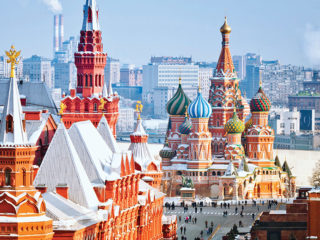
Meeting Women in Moscow: Dating Perspectives on the World’s Most Beautiful Women
- Posted on August 5, 2019 August 9, 2019

Meeting Russian Women: Top 5 Locations
- Posted on August 3, 2019 June 1, 2020
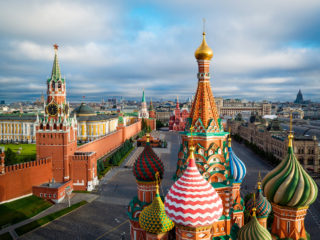
Moscow vs St. Petersburg – Which One to Visit?
- Posted on July 31, 2019 August 3, 2019

Hot Russian Girls – Where to Find & Date Them
- Posted on March 30, 2019 March 30, 2019
A Guide to Teaching English in Russia
- Posted on August 11, 2018 October 9, 2019

How to Attract Russian Girls
- Posted on July 15, 2018 August 4, 2019
Leave a Reply Cancel reply
Your email address will not be published. Required fields are marked *
Input your search keywords and press Enter.

IMAGES
VIDEO
COMMENTS
Antle is the owner and operator of The Institute for Greatly Endangered and Rare Species (T.I.G.E.R.S.), also known as the Myrtle Beach Safari. The Myrtle Beach Safari is a 50-acre wildlife tropical preserve that offers tours and private encounters with exotic wildlife.
Safari Sentence Examples. safari. Meanings Synonyms Sentences ... And, if you take the Portland MAX light rail system to the zoo, you'll get $1.50 off admission.The Wildlife Safari has a number of discounts. 0. 2. Today, the safari is alive and well and could be the greatest adventure you can have. 0. 2.
Nov. 6, 2023, 8:40 PM UTC. By Antonio Planas. Bhagavan "Doc" Antle, the owner of an exotic animal safari in South Carolina who gained recognition from the hit Netflix documentary series ...
1. As a Noun: When "safari" is used as a noun, it typically refers to an adventurous journey, often associated with wildlife exploration or sightseeing in natural habitats. It can also denote a guided tour or an organized trip, usually in Africa or other exotic locations. Here are a few examples:
The Myrtle Beach Safari is a 50-acre wildlife tropical preserve in Myrtle Beach. Sawyer and Bybee are Antle's employees and business associates. Sammut is the owner and operator of Vision Quest Ranch, a for-profit corporation that housed captive exotic species and sold tours and safari experiences to guests. Clay is the owner and operator of ...
A judge postponed Doc Antle's sentencing on his convictions out of Virginia until October 3. Back in June, a jury found Antle guilty of two counts of wildlife trafficking and two counts of ...
This is African safari, an evocative immersion in the wild world, an intimate insight into a wilderness that hasn't been tamed. The best way to think about it is to consider the etymology of safari. It's a Swahili word meaning "journey" and journey is the only adequate descriptive for the experience. It's a journey that connects you ...
A wild animal trainer featured in the popular Netflix series Tiger King has been convicted of wildlife trafficking in Virginia, the attorney general's office announced on Tuesday. Bhagavan ...
A judge will sentence Doc Antle at a Thursday hearing in Virginia. In June, a jury found Antle guilty of two counts of wildlife trafficking and two counts of conspiring to wildlife traffic.
Bhagavan Antle, who is known as Doc and is the owner of Myrtle Beach Safari in South Carolina, was charged with two felony counts related to wildlife trafficking and 13 additional misdemeanors ...
WILDLIFE SAFARI definition: A safari is a trip to observe or hunt wild animals, especially in East Africa. [...] | Meaning, pronunciation, translations and examples in American English. LANGUAGE. TRANSLATOR. ... Example sentences for ...
WILDLIFE SAFARI definition | Meaning, pronunciation, translations and examples
He will sentence Antle after receiving and reviewing a sentencing report prepared by the U.S. Probation Office. The FBI and the U.S. Fish and Wildlife Service are investigating the case. Senior Trial Attorney Patrick M. Duggan of ENRD's Environmental Crimes Section and Assistant U.S. Attorney Amy Bower for the District of South Carolina are ...
A safari of people. 89. An ingratitude of children. 90. A randy of rangers (as coined by the late Bob Griffin, a dear friend of &Beyond) NB: there is no official collective noun for pangolins because they are solitary; some say predicament; I prefer perfection. SEE WHAT LIES BEYOND. Subscribe to the Bateleur Magazine.
The meaning of SAFARI is the caravan and equipment of a hunting expedition especially in eastern Africa; also : such a hunting expedition. ... Examples of safari in a Sentence. ... 28 Feb. 2024 Perhaps one of the most distinctive features is the exotic wildlife sanctuary, ...
Examples Of Using Safari In A Sentence. We went on a safari in Africa and saw lions, elephants, and giraffes. My dream vacation is to go on a safari in Tanzania. ... Wildlife Viewing: If the primary objective of the trip is to view wildlife, then a safari might be the better choice. Safaris are typically associated with game drives and guided ...
First day on safari: slow gnus day. It's been an excellent night for the predators of the Serengeti. As the sun starts to inch over the horizon and casts a pale light over the acacia-pocked plains, it reveals a scene of nocturnal carnage. There are bones here, bones over there, bones everywhere. White bones picked clean and dazzling as if ...
We embarked on a wildlife safari to observe rare species. 3. Compound Noun: "Wildlife" can also be part of a compound noun, combining with other words to form a specific term related to animals or nature. Here's an example: ... Example Sentence: The wildlife tracker had eagle-eyed vision, spotting the hidden footprints of a rare species ...
Colorful pictures depict the varied wildlife of the area. Picnic on board, watch wildlife, moor at a waterside pub. The biologists would like to do more research on the wildlife thriving in the depths of the ocean's abysses. It will help you to spot wildlife on the mainland when you pass by on the ship.
The breath of wildlife and the chance to be closer to the virgin nature excites both children and grownups. Hundreds of different species of animals can be found in Moscow nature parks. The richest woodlands with old and even ancient trees, like a 200 years pine-tree in the Elk Island National Nature Park, are the point of passionate interest ...
In the 1950's to 1972, Olympic Game Farm (then called Disney's Wild Animal Ranch) was originally designed as a holding facility for the animal actors of Disney Studios. During breaks from filming, the animals were trained, housed, and cared for while waiting for future filming. Disney Studios had asked us to keep the public and cameras out ...
This tour of Moscow's center takes you from one of Moscow's oldest streets to its newest park through both real and fictional history, hitting the Kremlin, some illustrious shopping centers, architectural curiosities, and some of the city's finest snacks. Start on the Arbat, Moscow's mile-long pedestrianized shopping and eating artery ...
Moscow nightlife starts late. Don't show up at bars and preparty spots before 11pm because you'll feel fairly alone. Peak time is between 1am and 3am. That is also the time of Moscow nightlife's biggest nuisance: concerts by artists you won't know and who only distract your girls from drinking and being gamed.